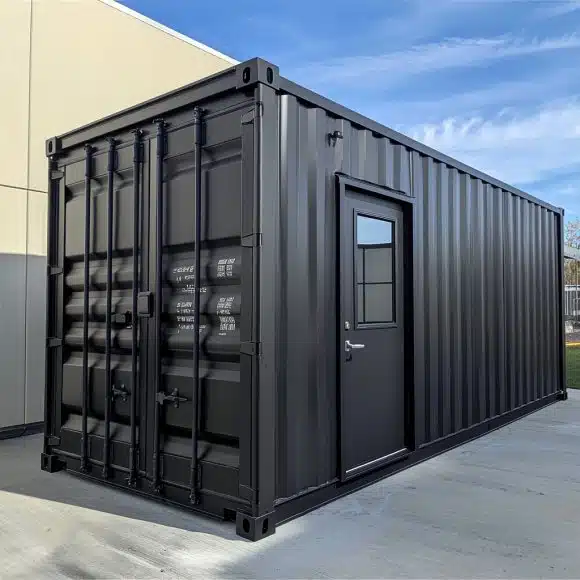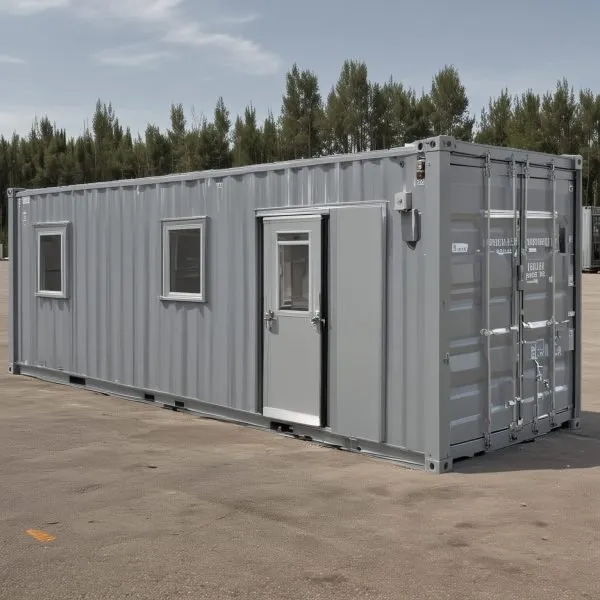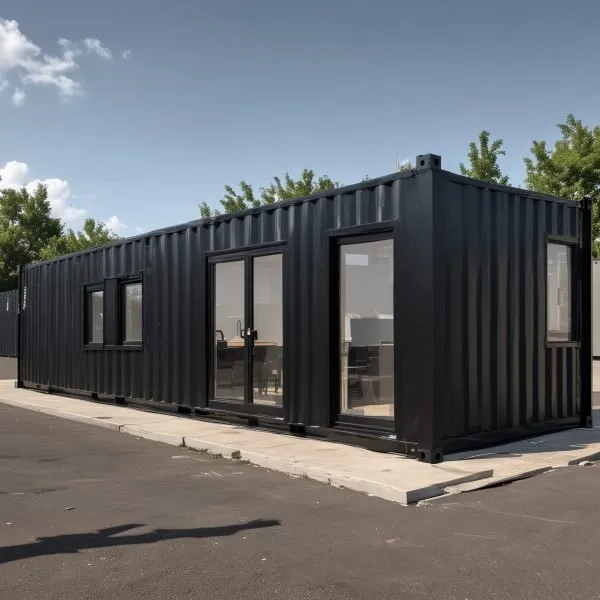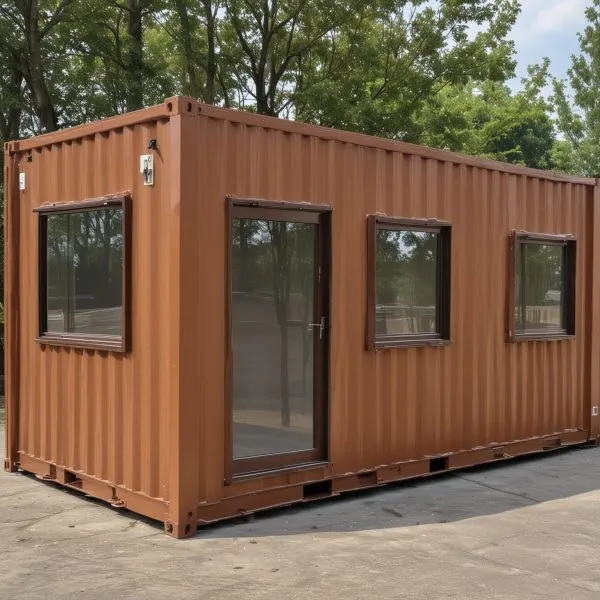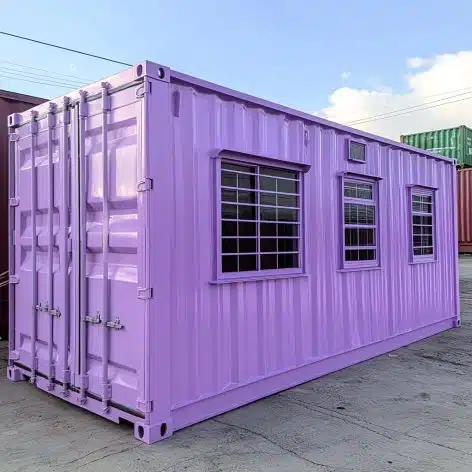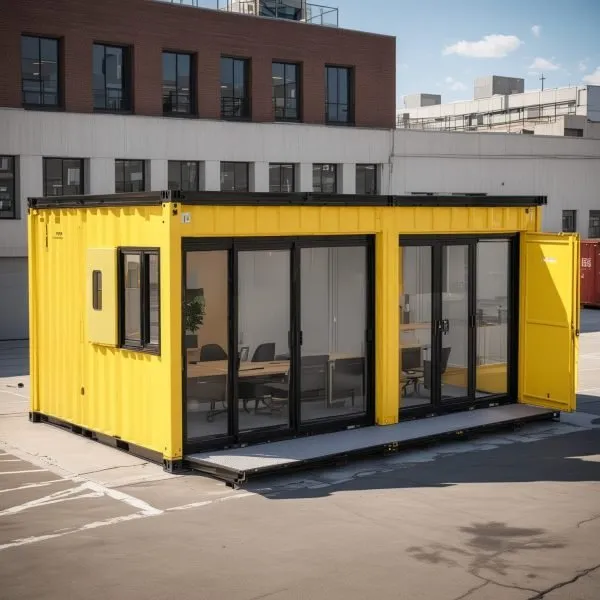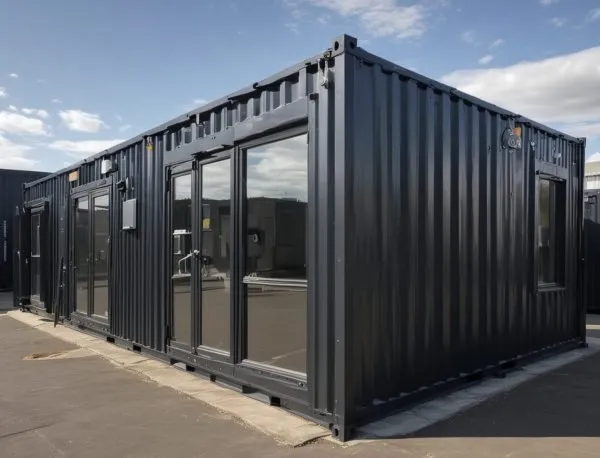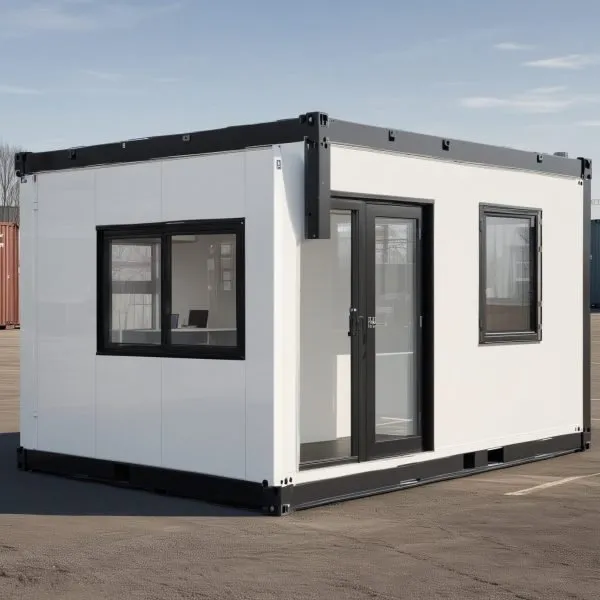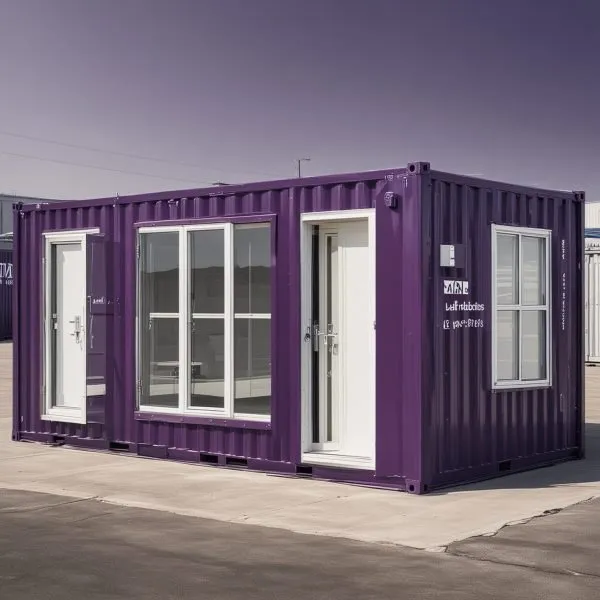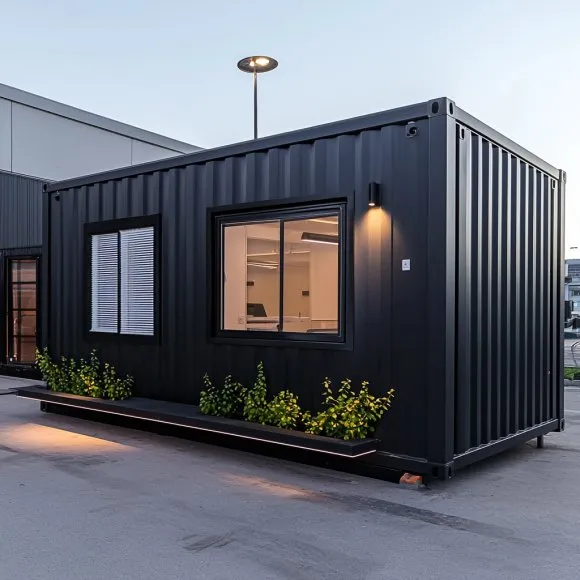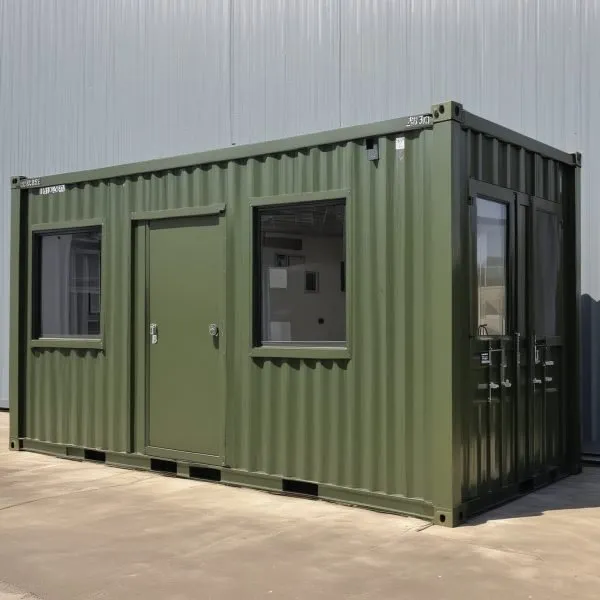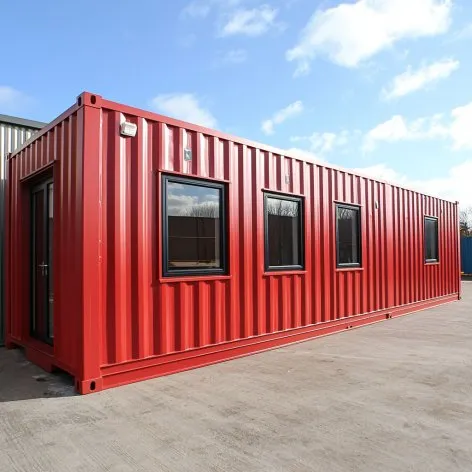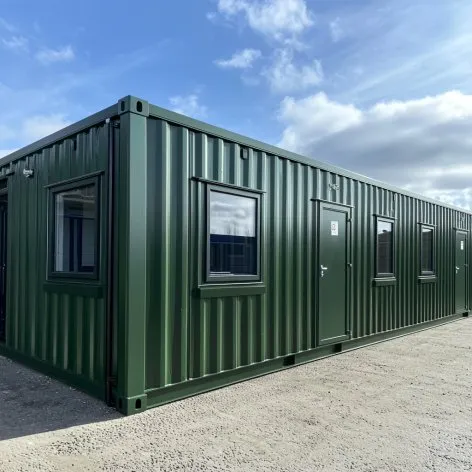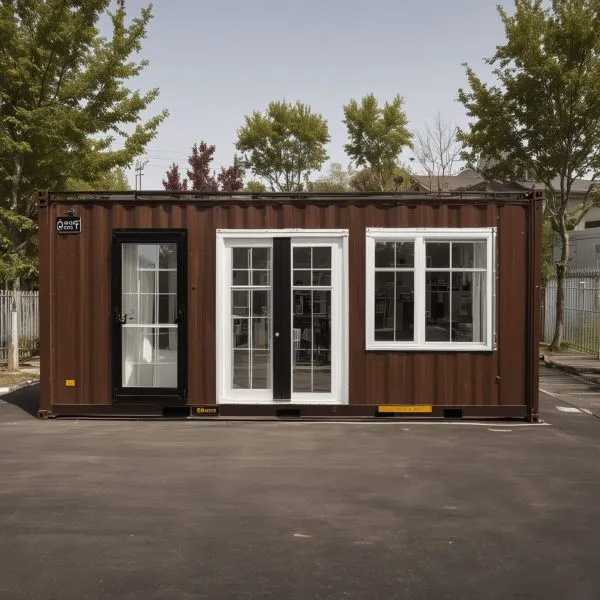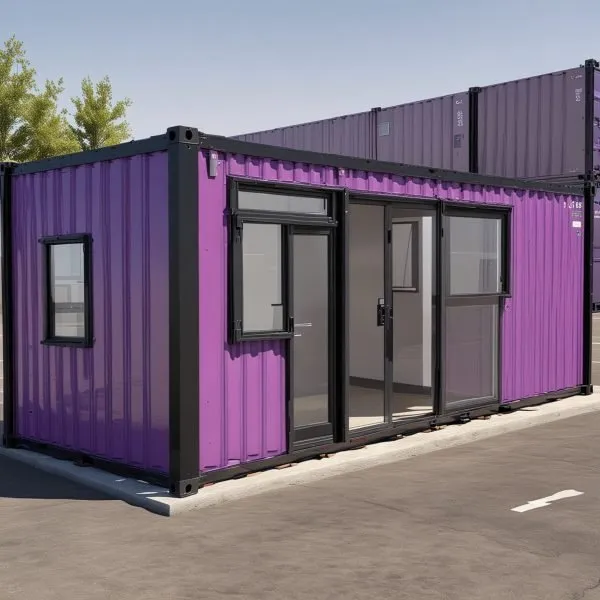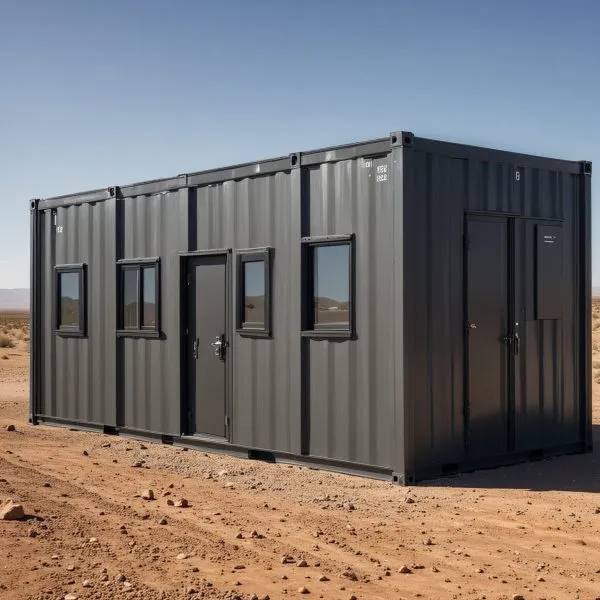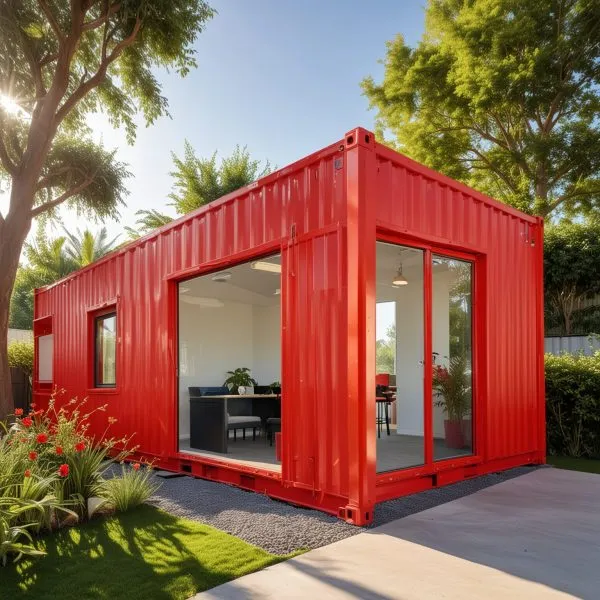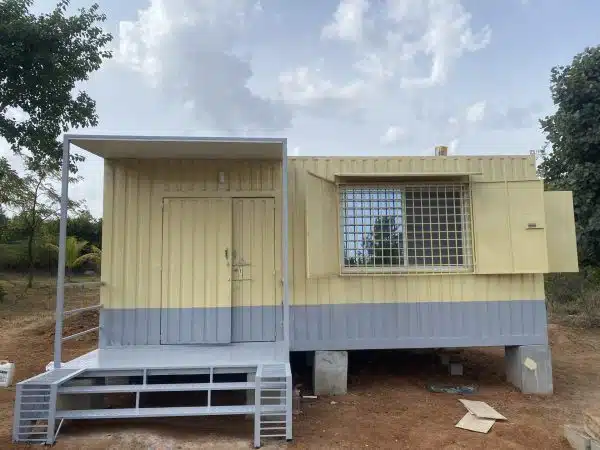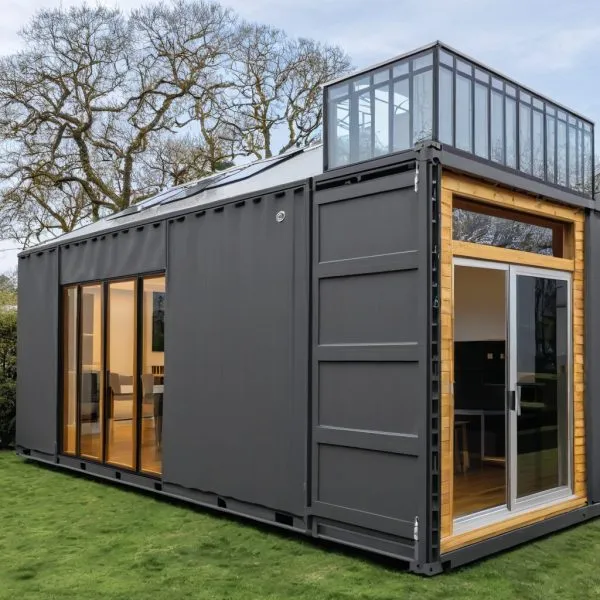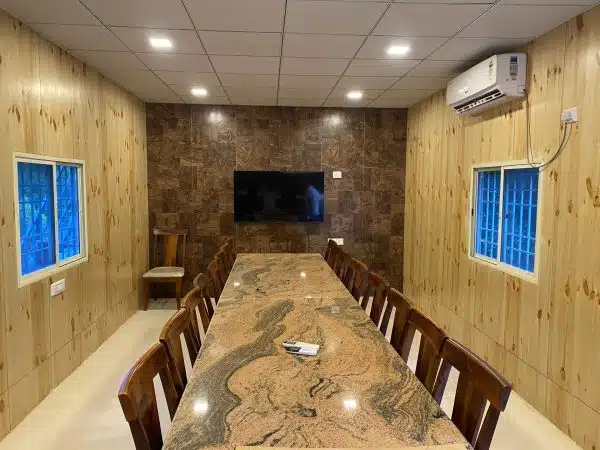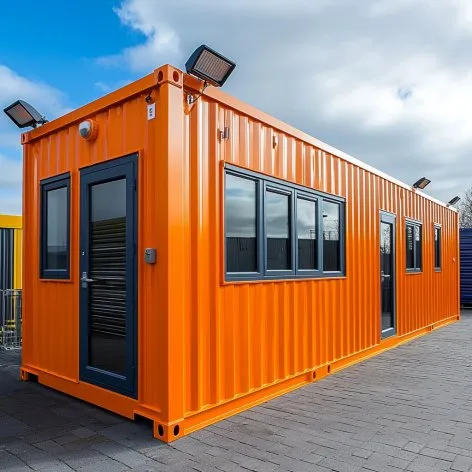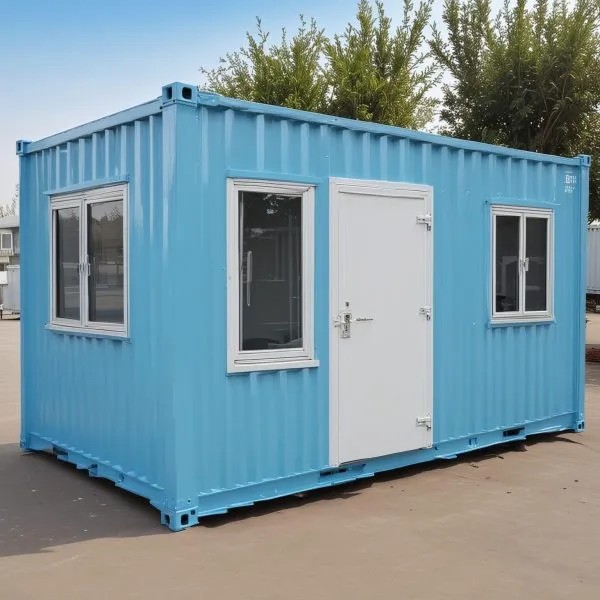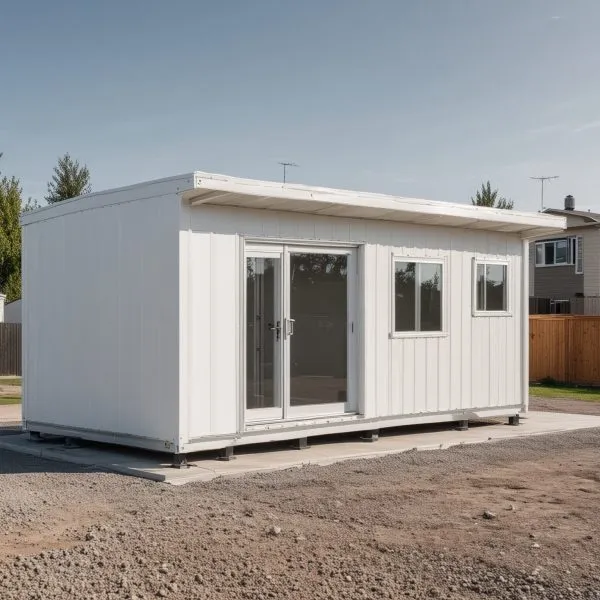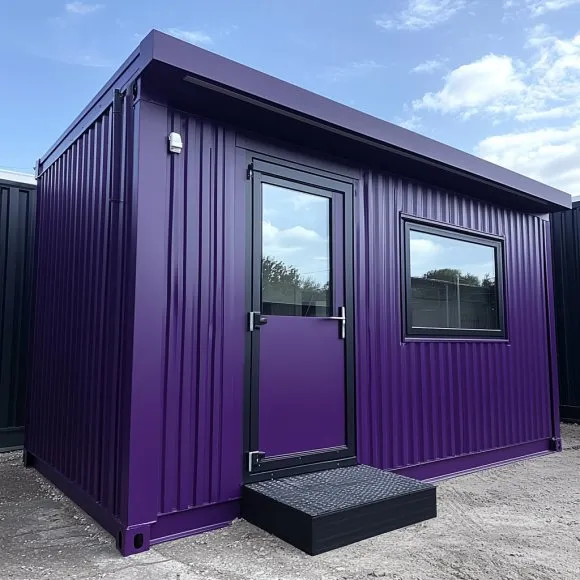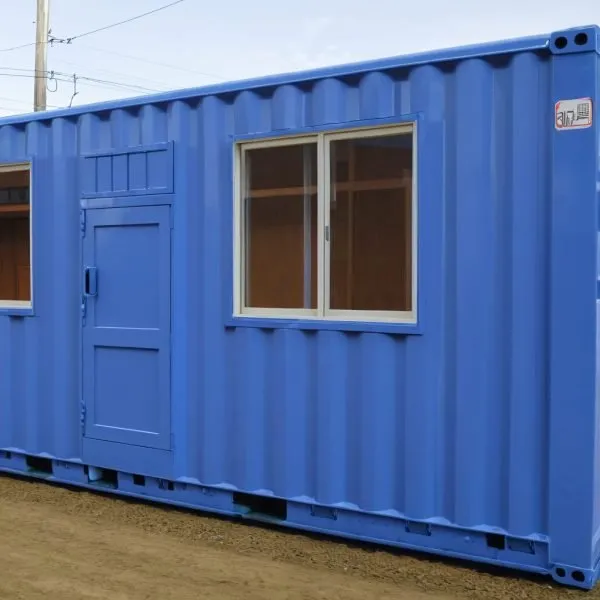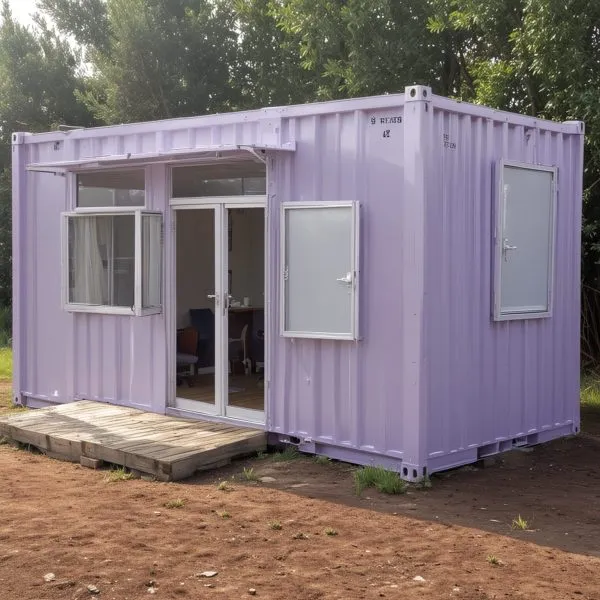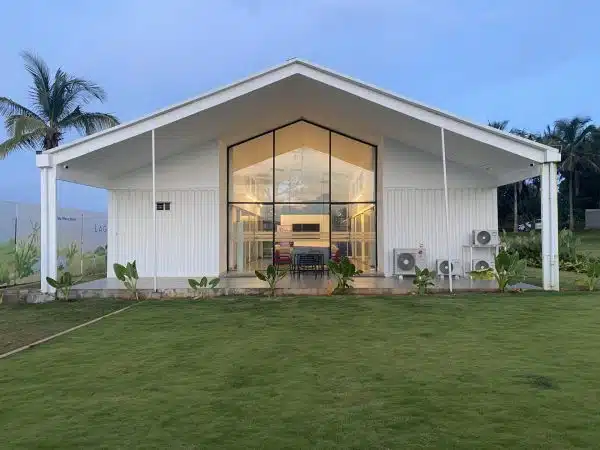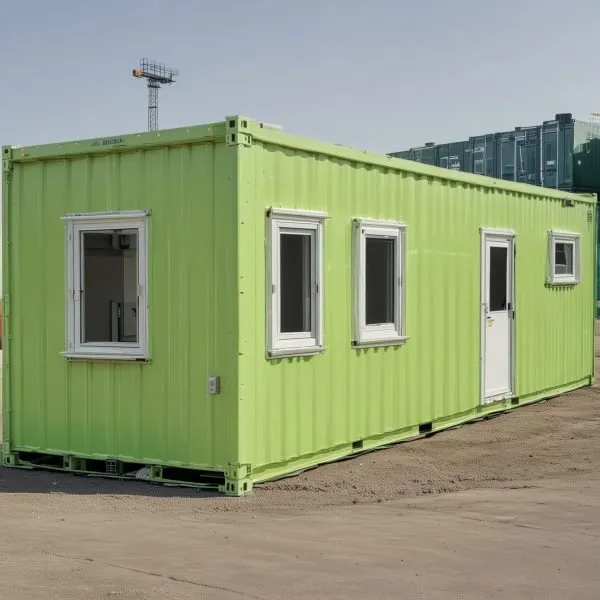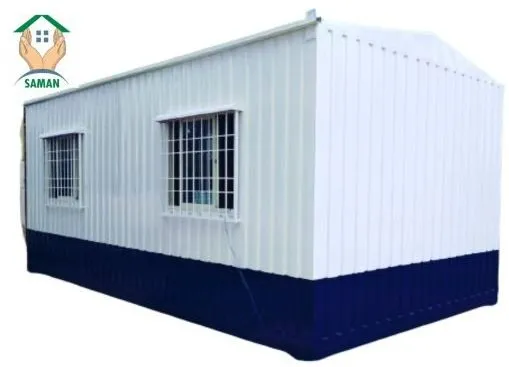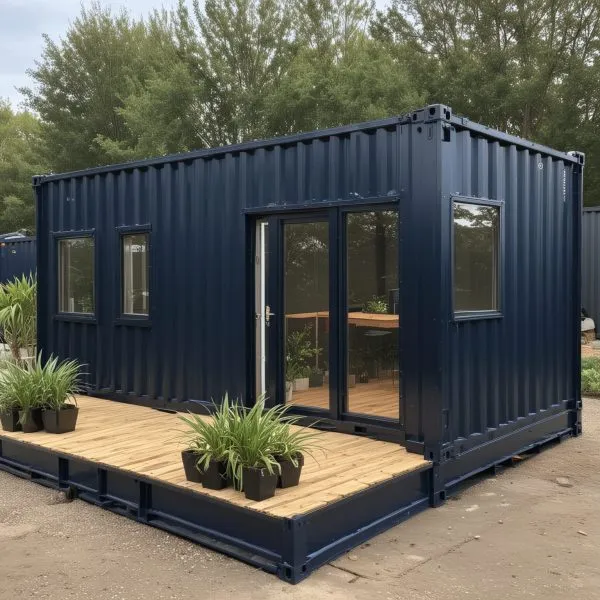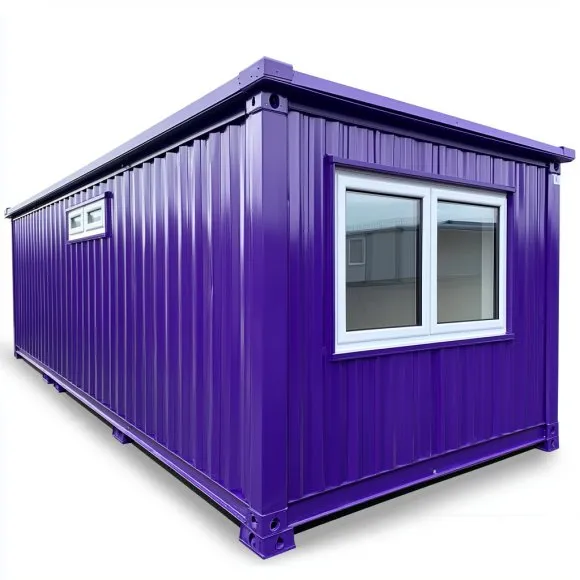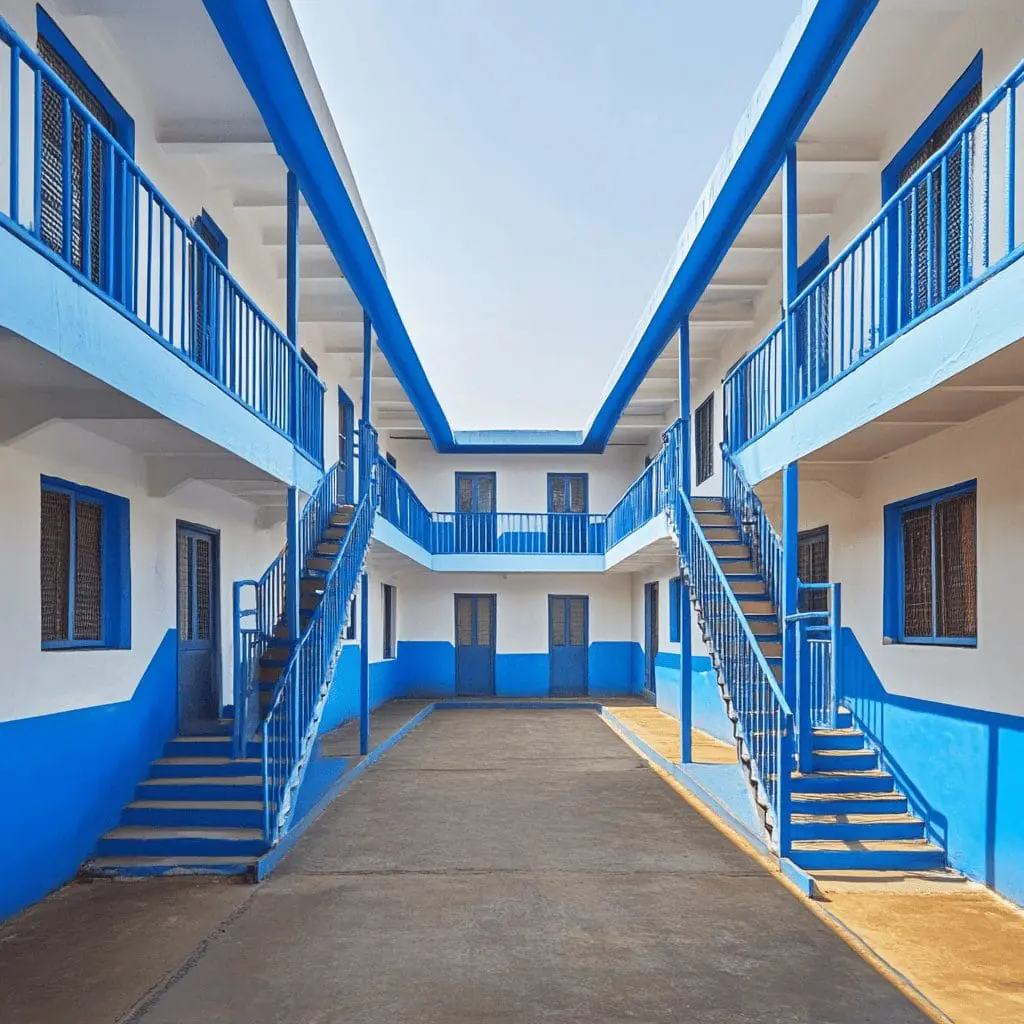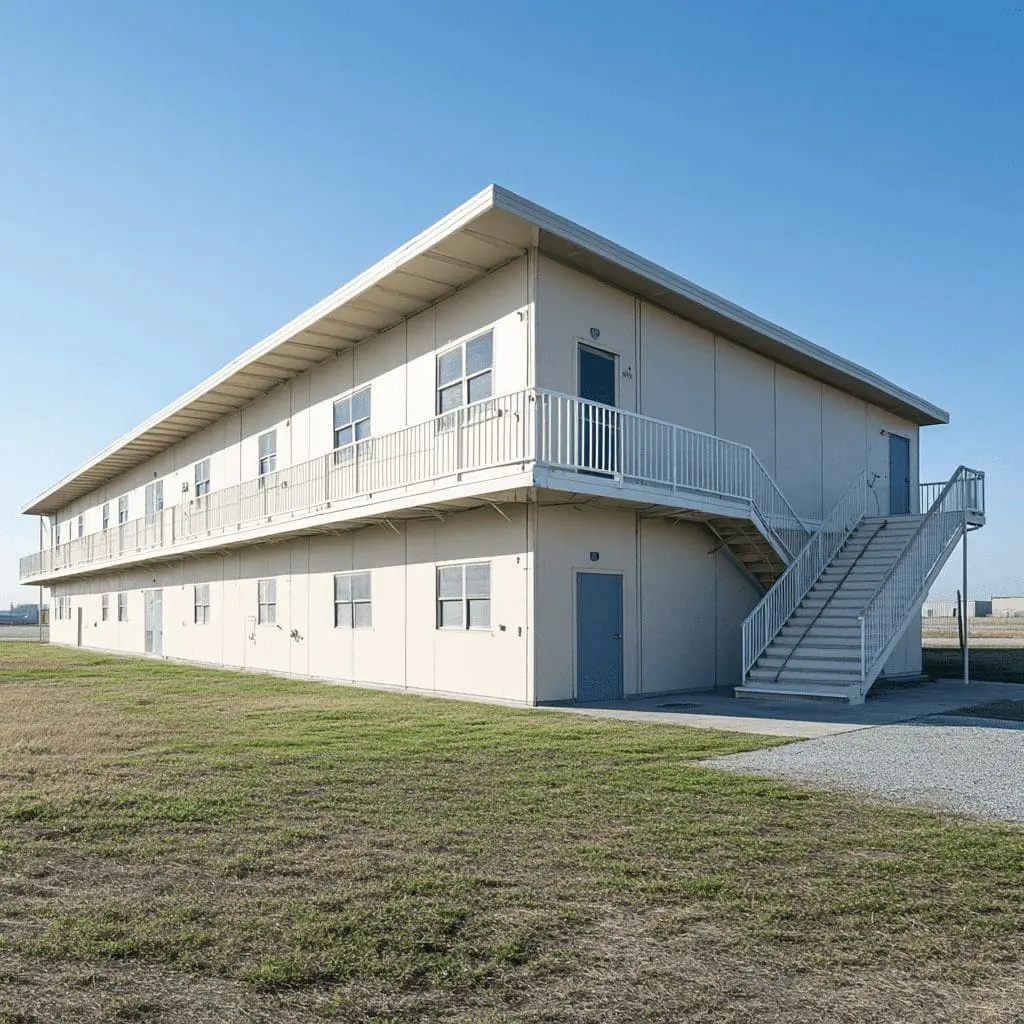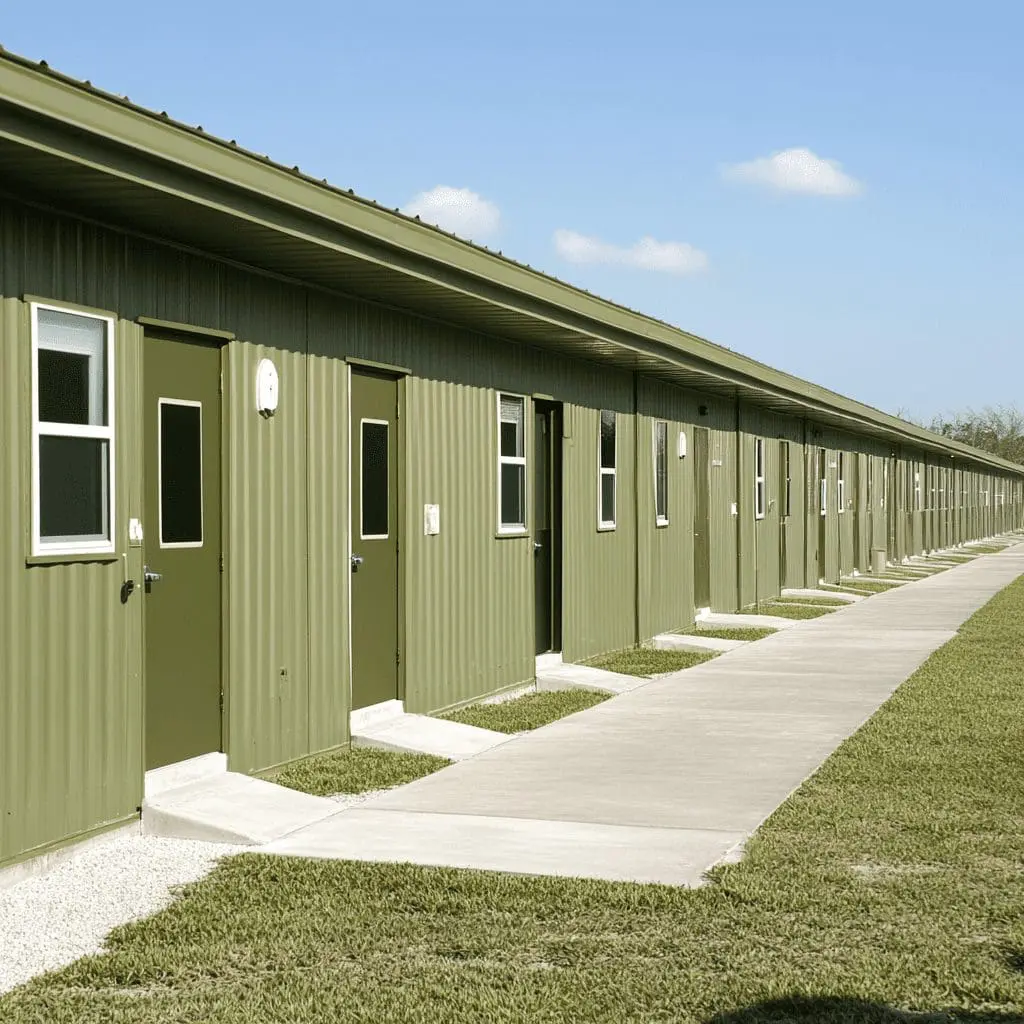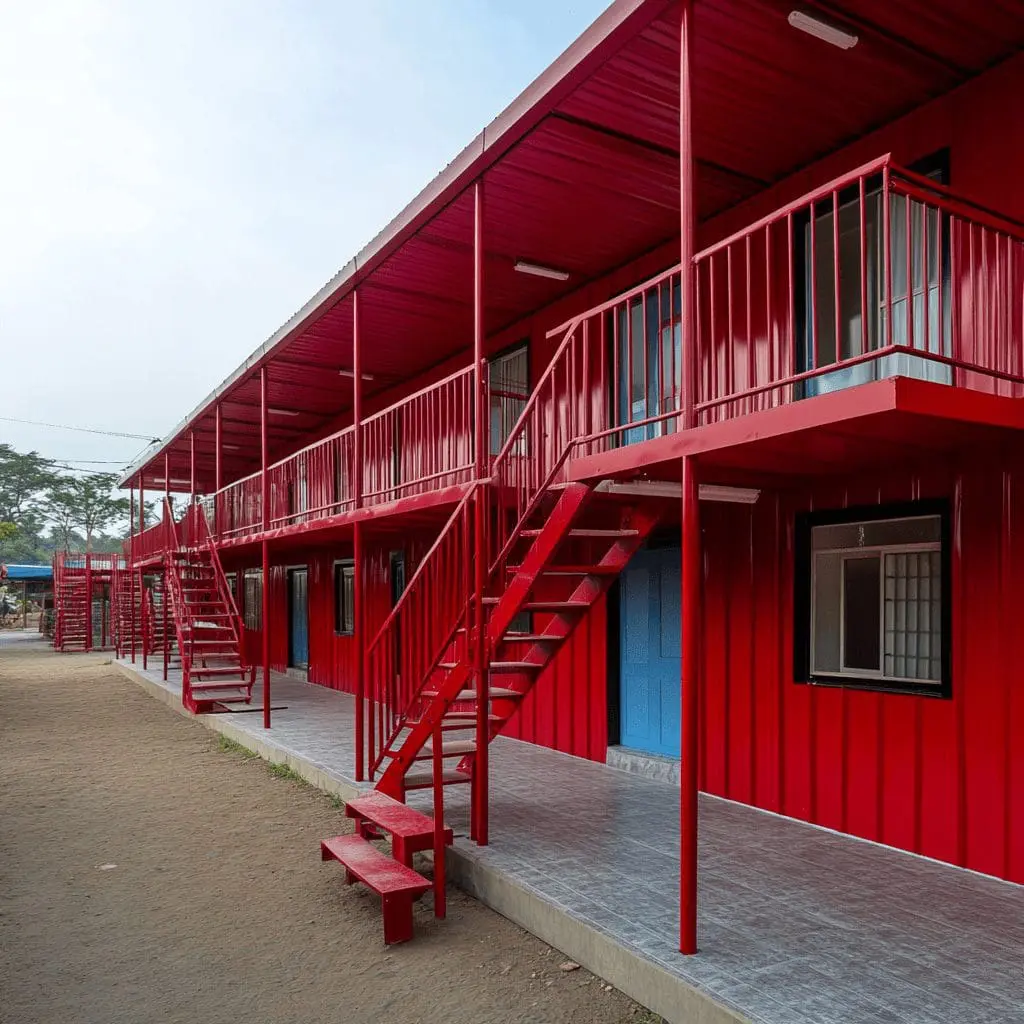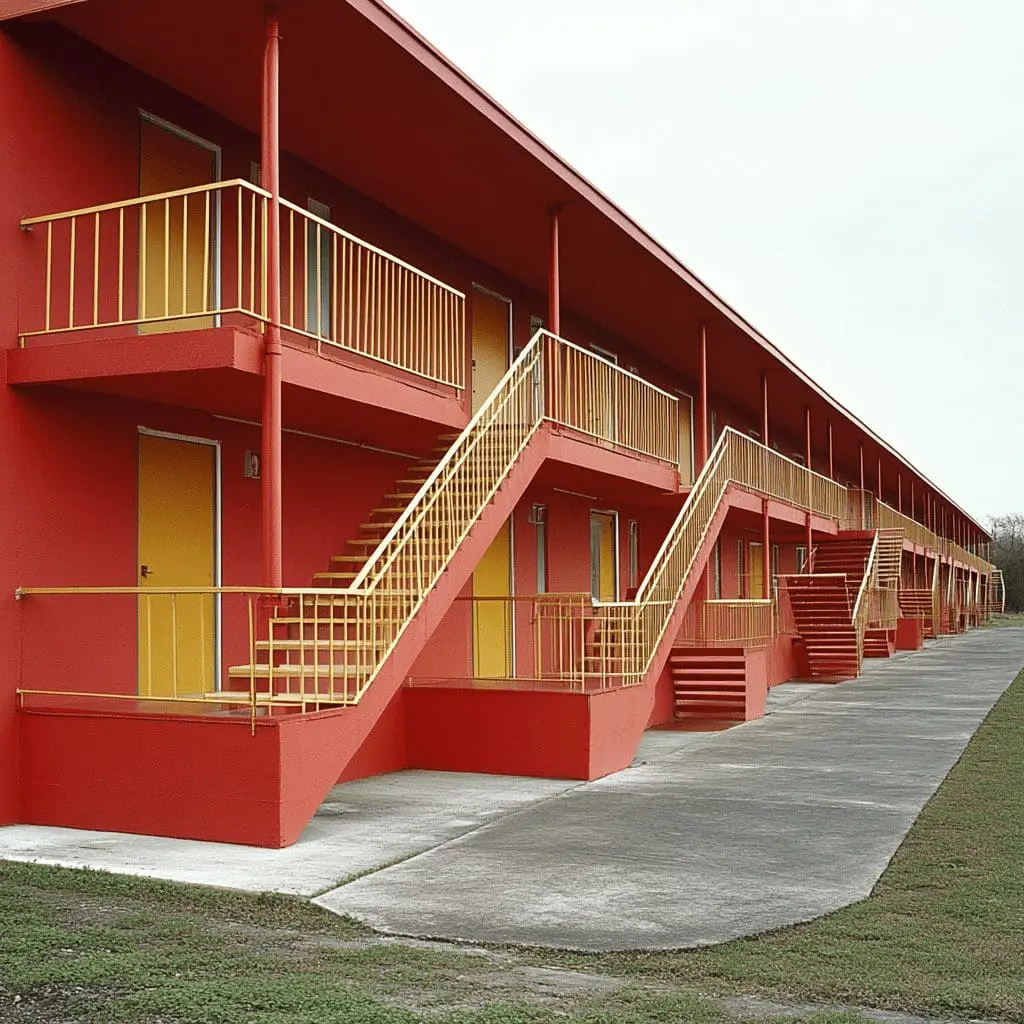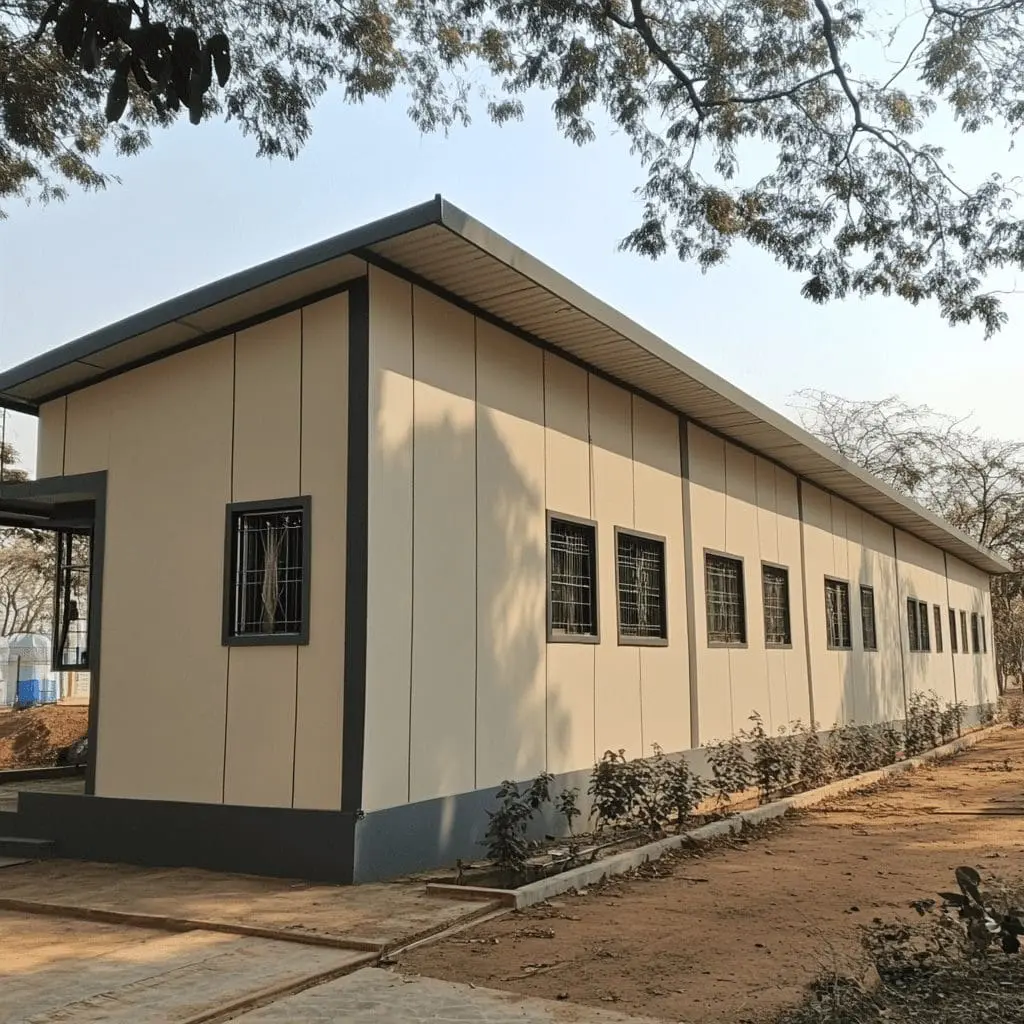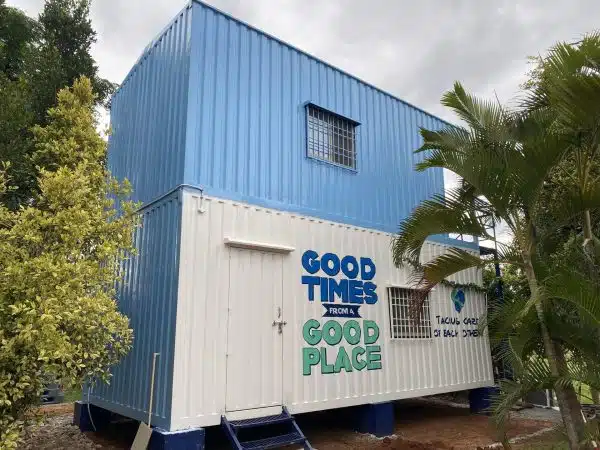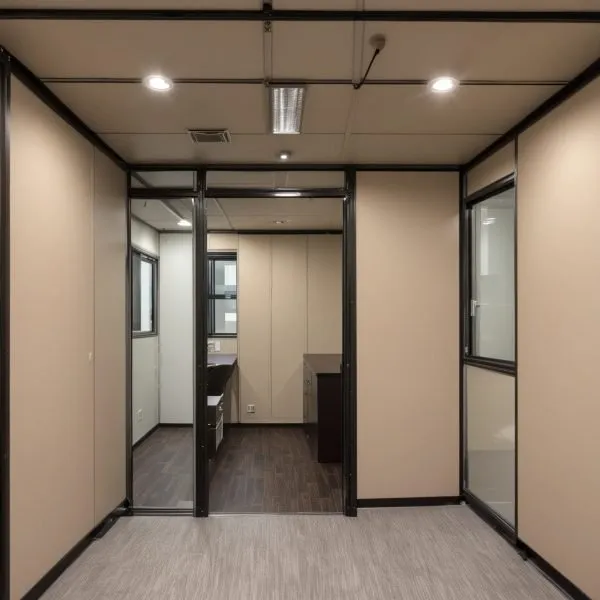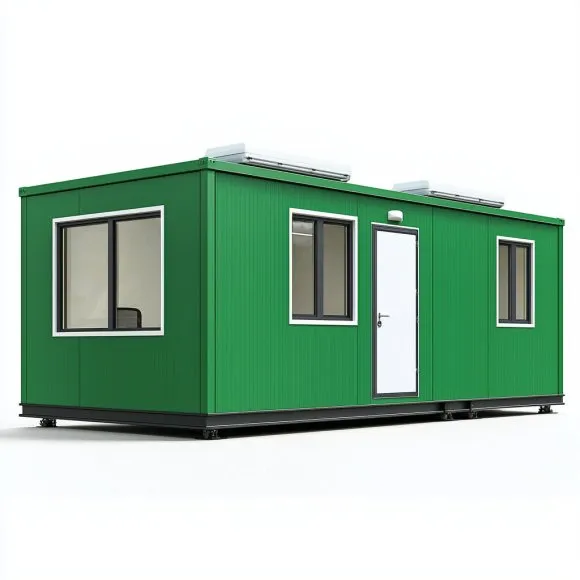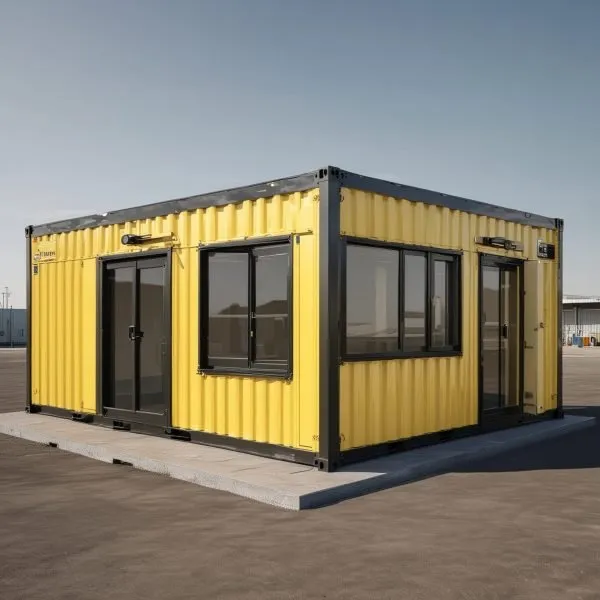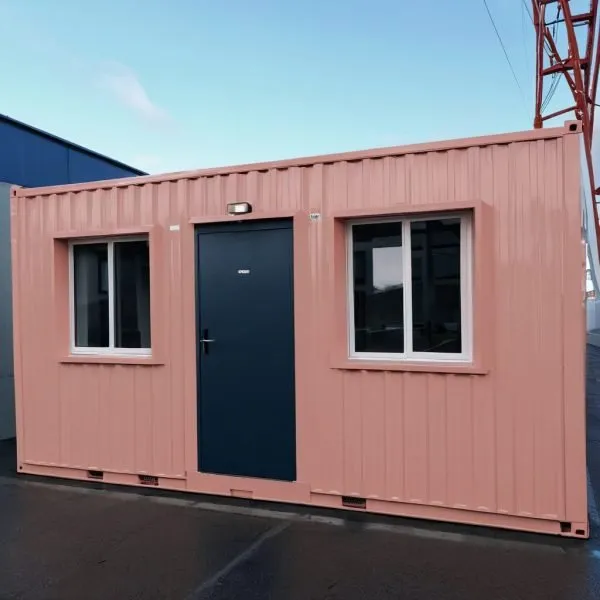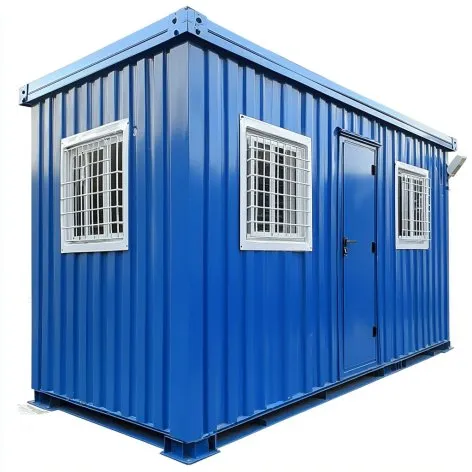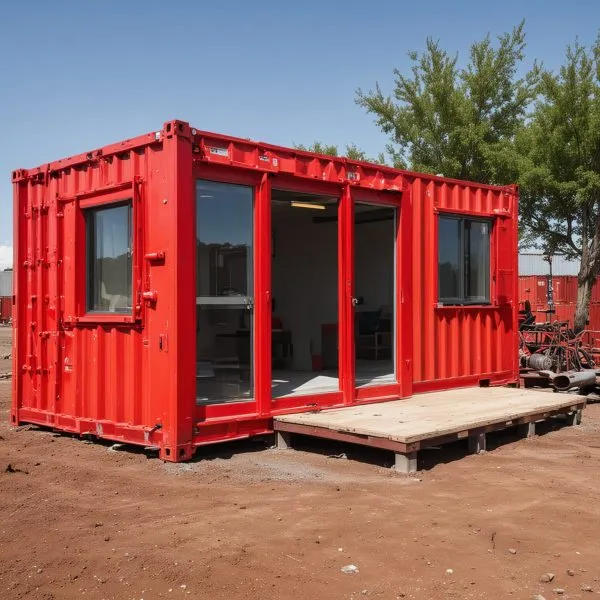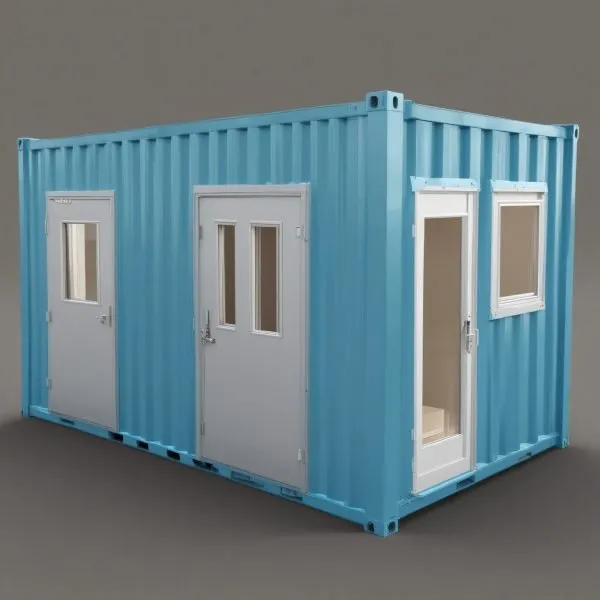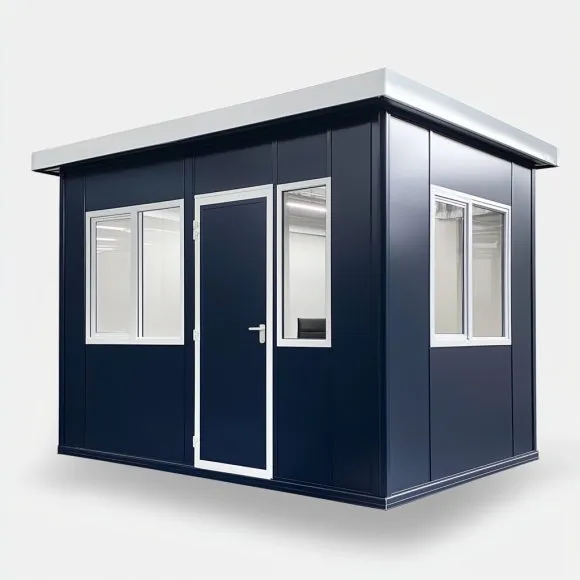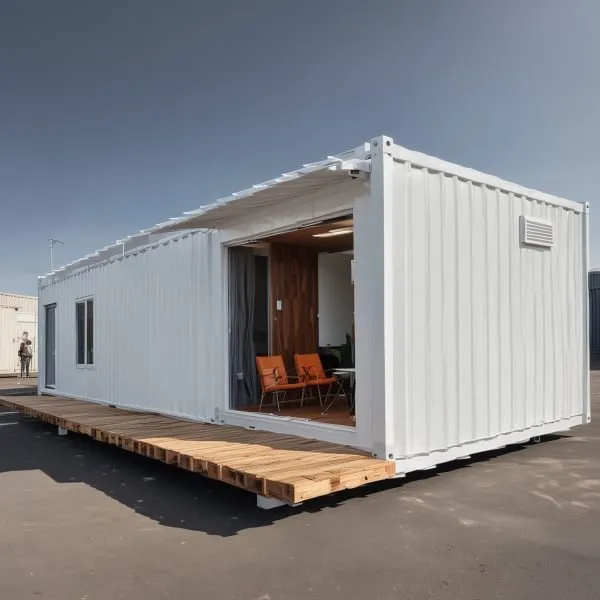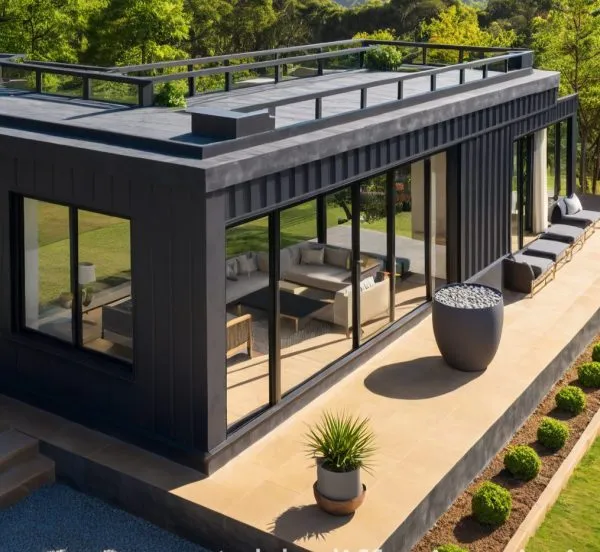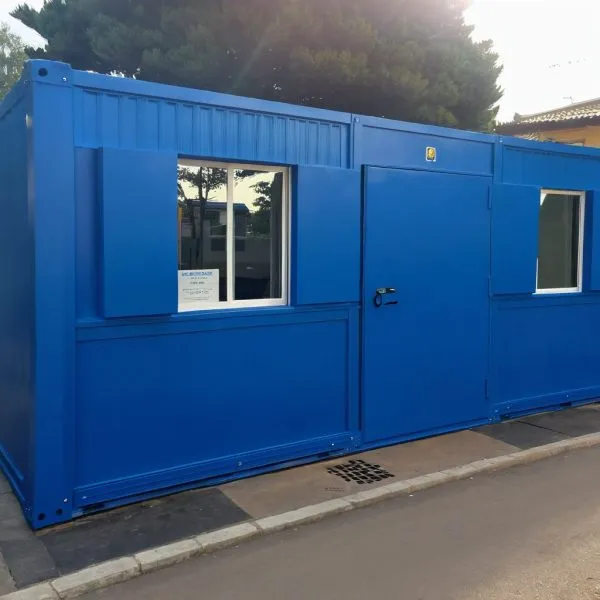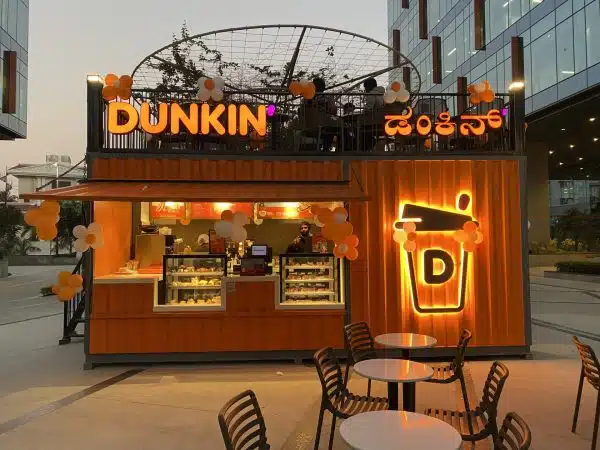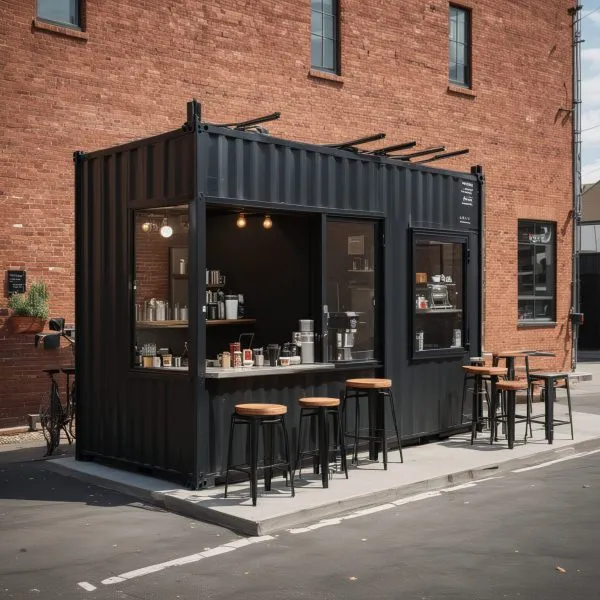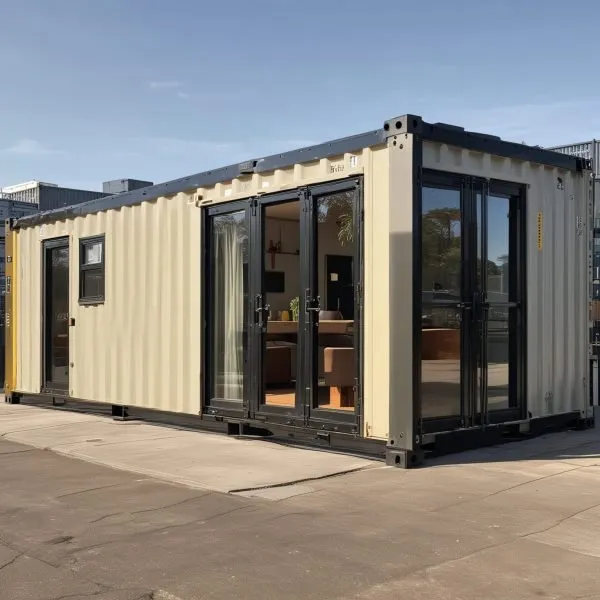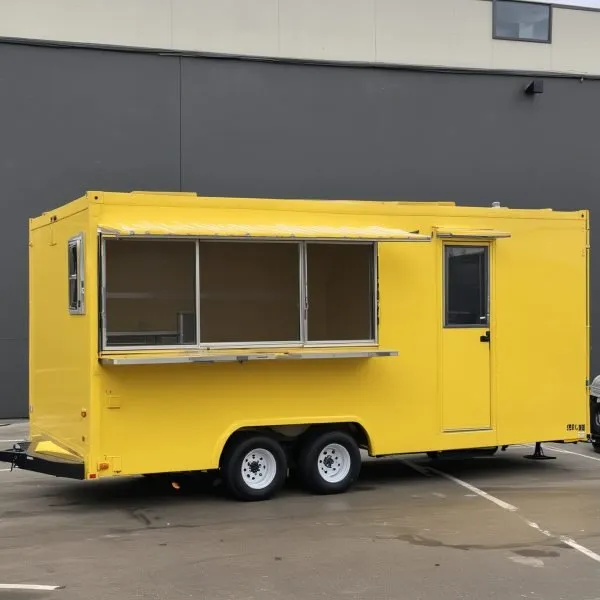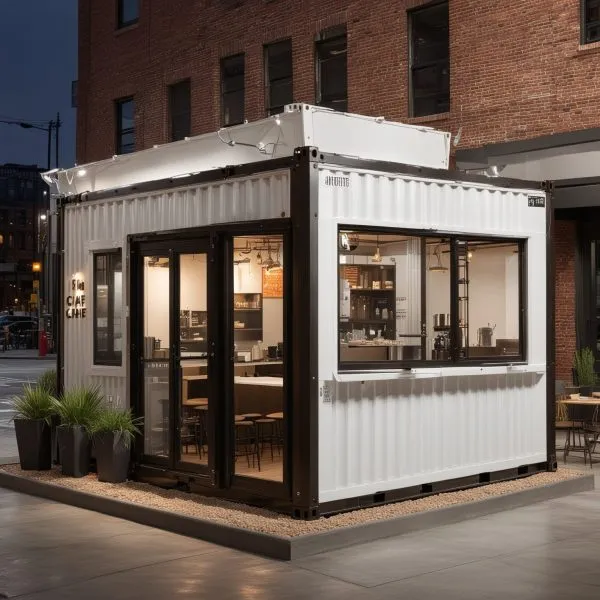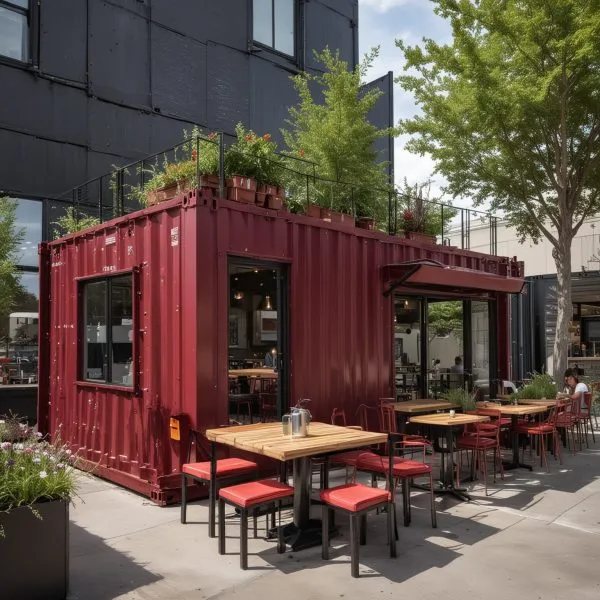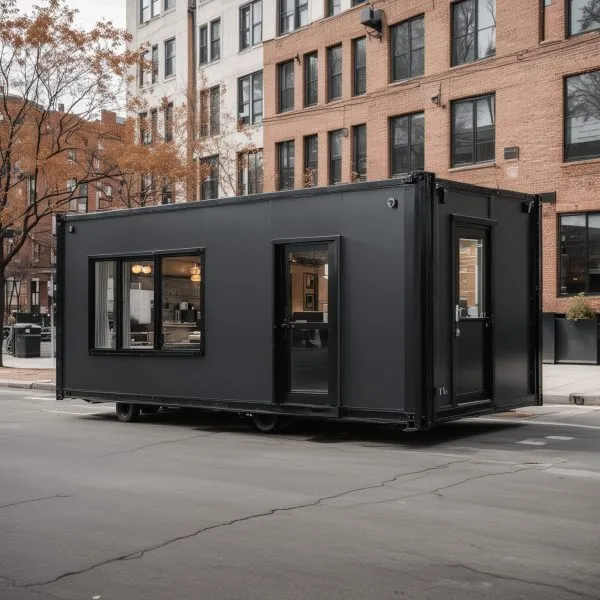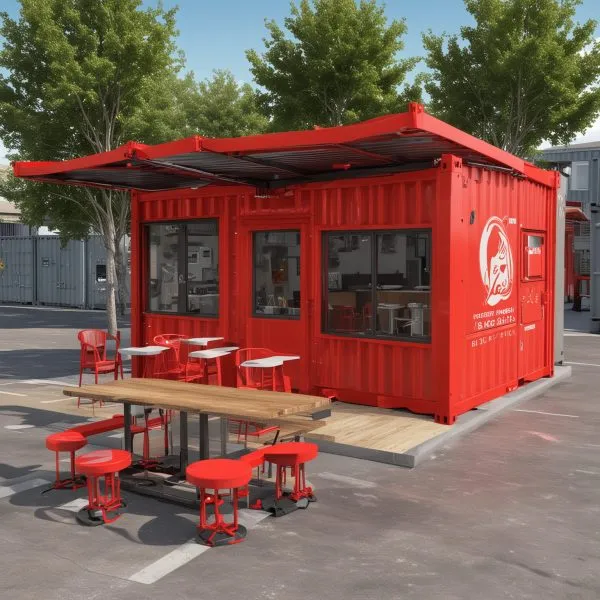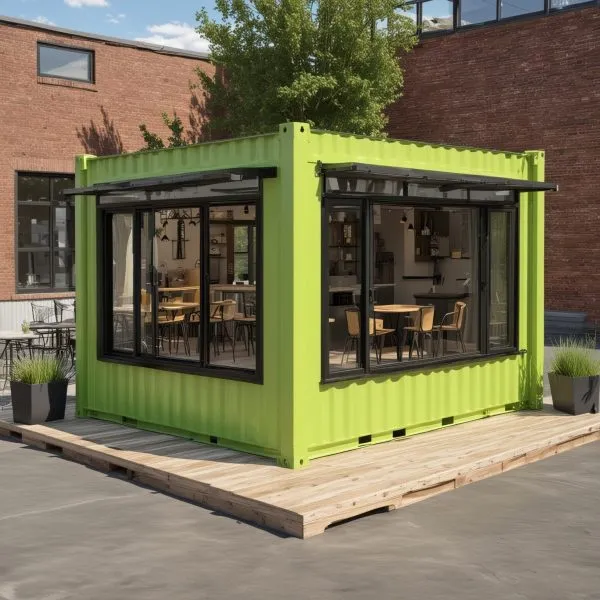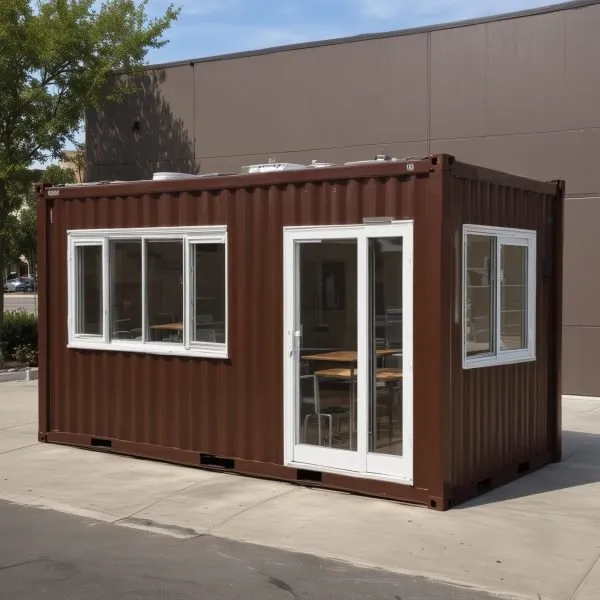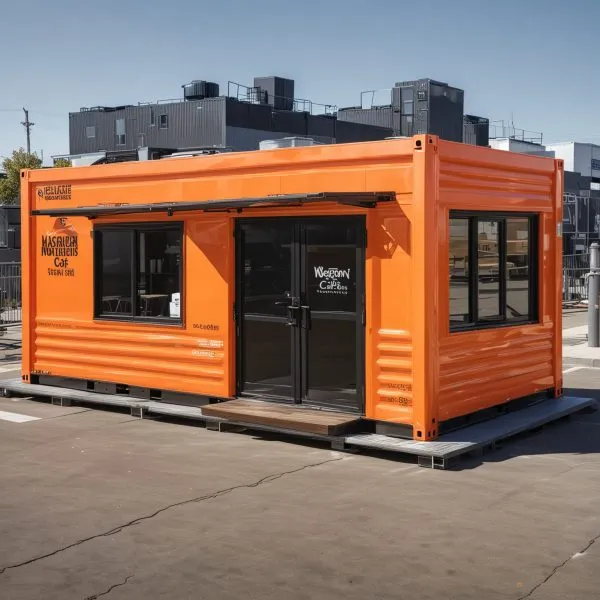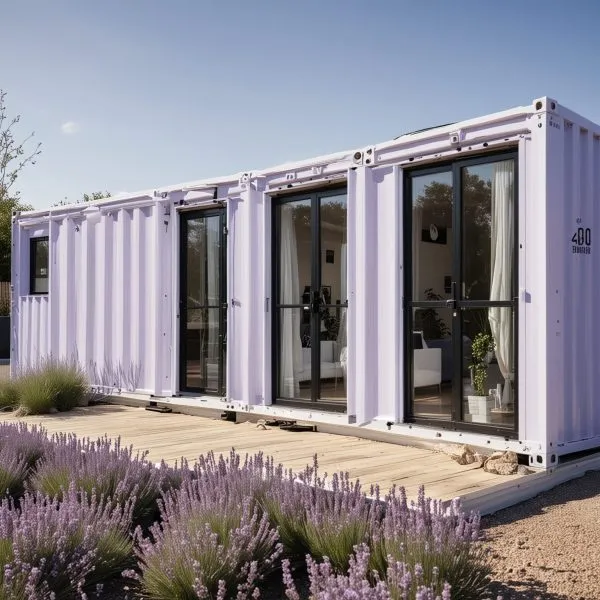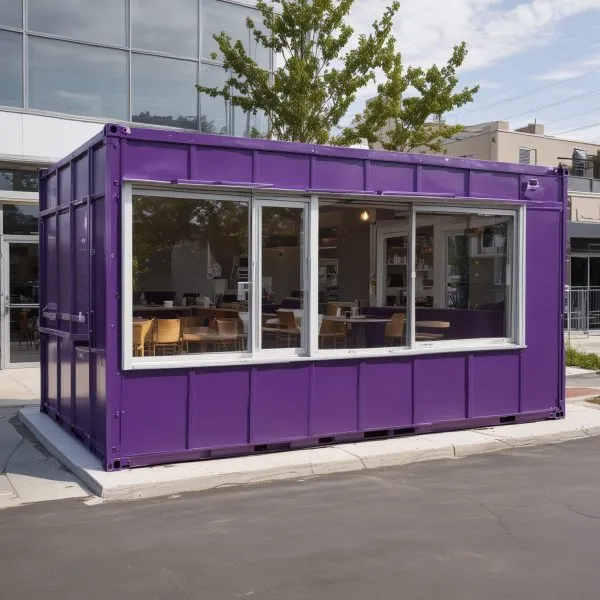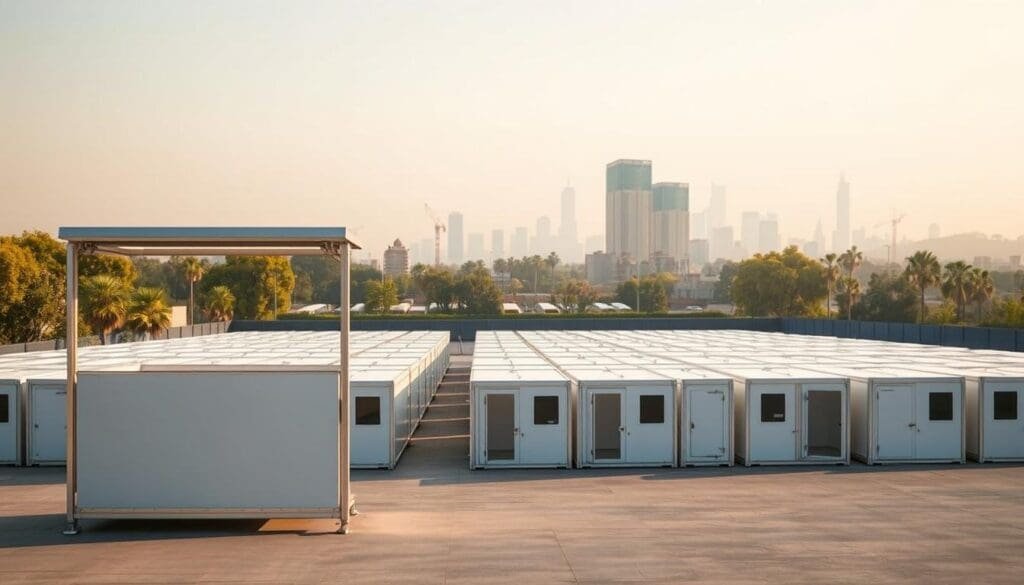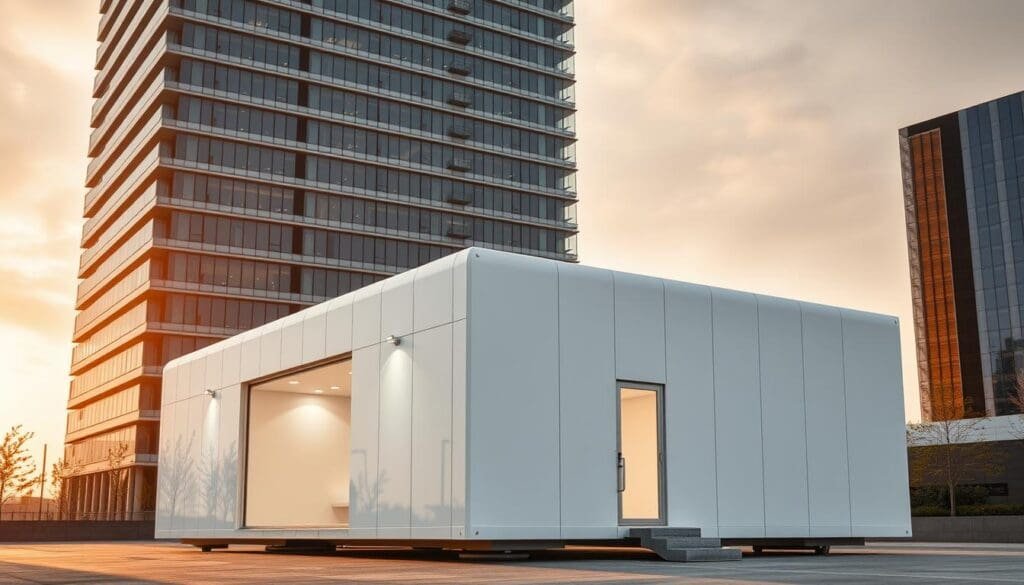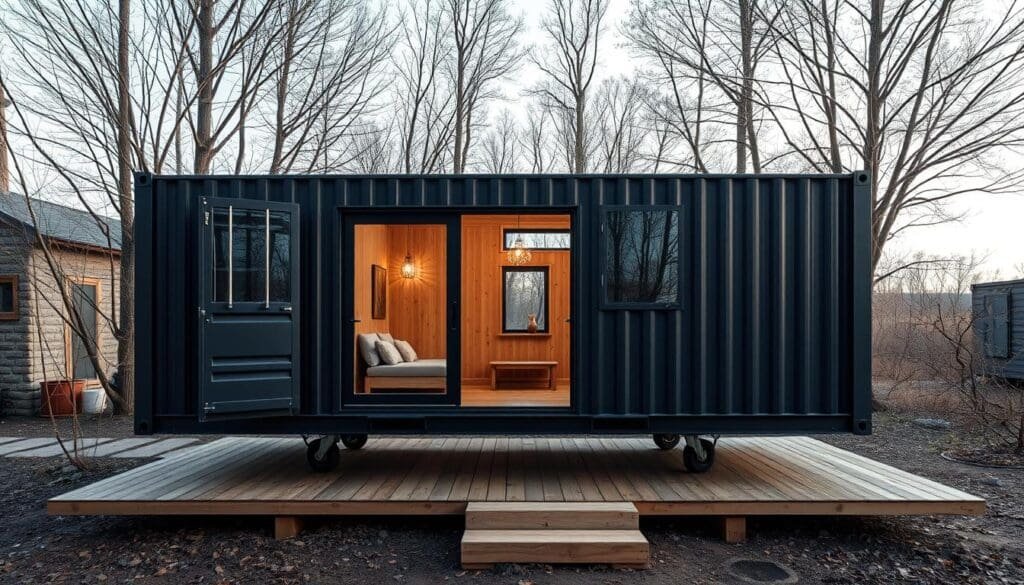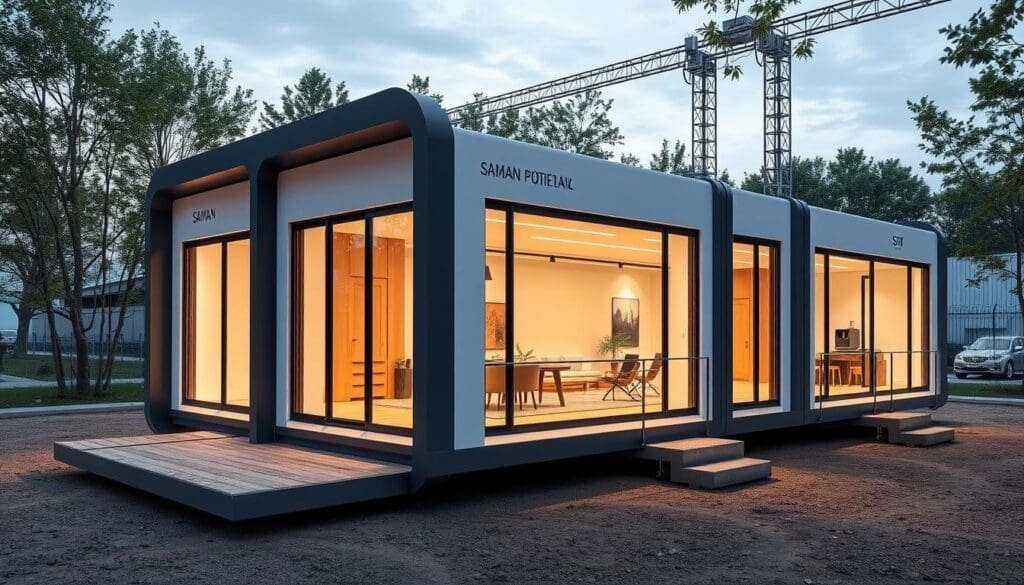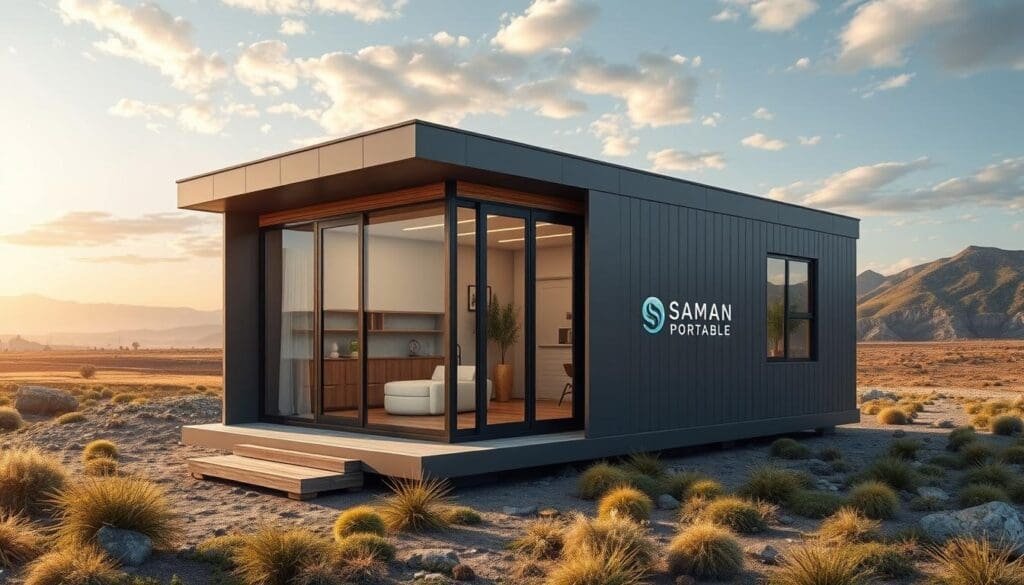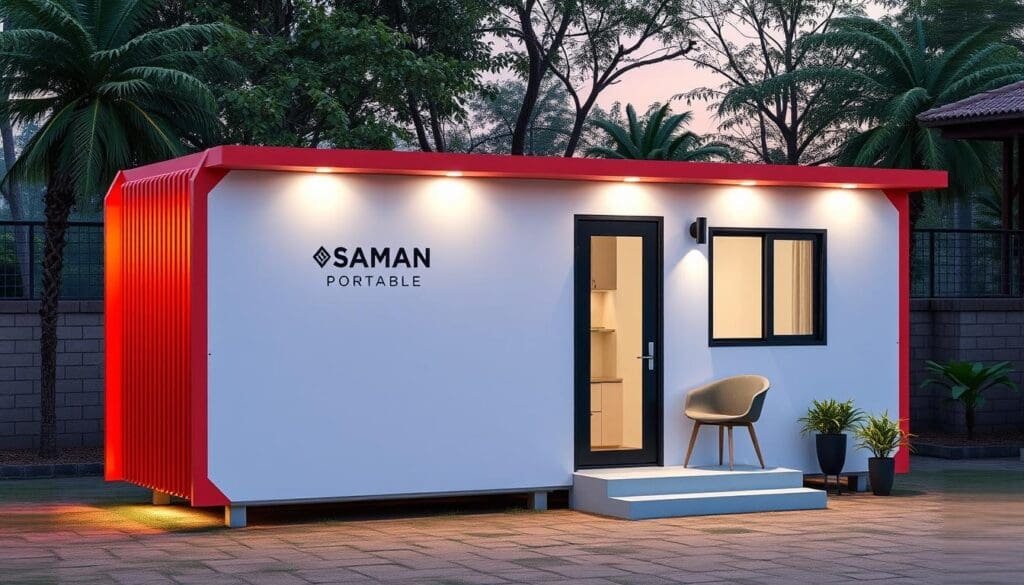Top Ideas for Shipping Container Buildings: Sustainable, Cost-Effective Solutions
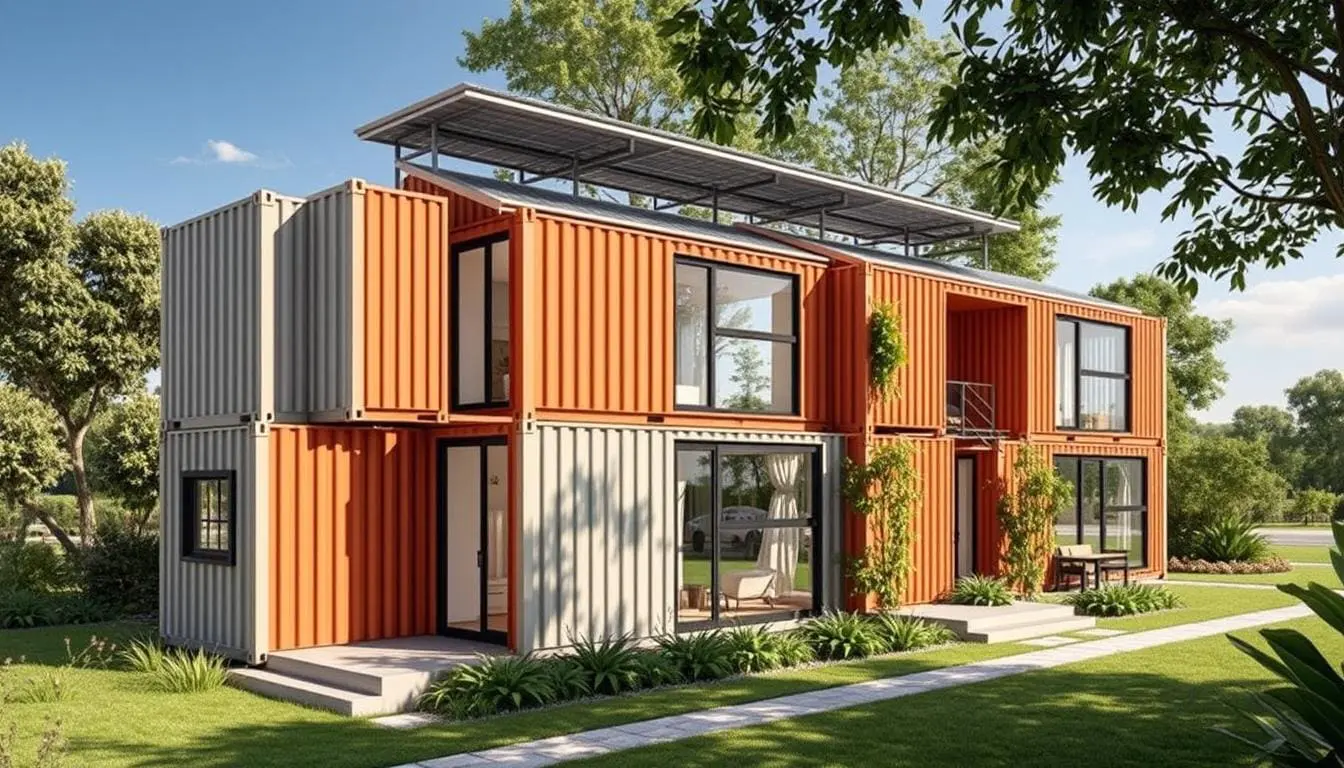
Shipping container buildings are changing the game in architecture and construction. They appeal to those who care about the environment and want to save money. Let’s dive into the best ideas for using shipping containers in building. They’re making construction more sustainable and affordable.
Discover how Comprehensive Container Office Designs and Plans can transform workspaces into modern, sustainable hubs for productivity. Explore innovative layouts and features today.
Key Takeaways
- Shipping container buildings offer a unique blend of modern design and sustainability
- Repurposing used containers reduces the need for traditional building materials, significantly cutting costs
- Containers are durable, weather-resistant, and versatile, allowing for customization to fit project needs
- Shipping container architecture is being applied across a wide range of sectors, from residential to commercial and community spaces
- Sustainable features and eco-friendly solutions are integral to the container building concept
Understanding the Container Architecture Revolution
The way we build has changed thanks to container architecture. What began as simple storage has evolved into a versatile, innovative method. It creates sustainable, cost-effective structures with a unique look. Architects, designers, and eco-conscious people around the world are taking notice.
Evolution of Container Architecture
Shipping containers, once for cargo, now serve as building blocks. Their strength and flexibility make them ideal for various structures. This shift has led to a revolution in building, making it more sustainable and affordable.
Key Benefits of Container Construction
Container construction offers many advantages. They are cost-efficient, with shipping costs plummeting since their introduction. Containers are flexible, allowing for creative space designs. They can handle weight and weather well, thanks to materials like corten steel.
Global Impact on Sustainable Building
Container architecture has a big impact on sustainable building. It reduces waste and cuts down on the need for new materials. These structures can be energy-efficient with the right insulation and ventilation. Their flexibility leads to unique spaces that support a sustainable future.
From residential to commercial applications, Innovative Container Buildings offer eco-friendly solutions for modern construction demands.
Cost Analysis of Container Building Projects
Shipping container buildings are a smart choice for those looking for affordable and green construction. New containers cost between $3,000 and $5,000. Used ones can be found for as low as $1,200. But, the total cost of a project is more than just the container’s price.
Our research shows that basic changes for a container home start at under $50,000. This includes insulation, windows, doors, and interior finishes. Adding utilities like water, electricity, and sewerage can cost about $10,000 more. A single-container home usually costs between $25,000 and $35,000. A double-container home can cost from $40,000 to $70,000.
Container buildings can save money in the long run. They are often more energy-efficient, which means less maintenance and possibly lower insurance. Plus, building a container home is usually faster than traditional homes, saving on construction costs.
When planning a container building project, making a detailed budget is key. It’s important to categorize costs, manage tradeoffs, and make smart decisions. By considering all project aspects, from site prep to interior design, we can keep container buildings affordable and sustainable.
In conclusion, the cost-effectiveness of container buildings is why they’re becoming more popular. With various price options and long-term savings, they’re a great choice for those watching their budget.
Essential Design Principles for Container Structures
The container architecture movement is growing fast. It’s key to follow important design rules for making these buildings work well and last long. These rules include smart space use, making structural changes easy, and adding natural light.
Space Planning and Layout Optimization
Starting with good space planning is the first step. Using every inch and adding vertical storage helps a lot. Designers need to think about how people move and where to put furniture and appliances.
Structural Modifications and Requirements
Changing a shipping container’s structure is tricky. Cutting walls can open up space, but each change must be well thought out. Containers are built to handle strong shakes, even stronger than the strongest in the U.S., so they’re very strong. It’s important to add support and make smart openings to keep them strong.
Integration of Natural Light
Windows and skylights are key for letting in natural light. This makes spaces feel bigger and brighter, and it saves energy by using less artificial light. Insulation and air flow are also important for comfort and saving resources.
Following these design rules helps make container buildings that are good for people and the planet. By focusing on space, structure, and light, we can create places that are both practical and beautiful.
Looking for cost-effective and innovative designs? Dive into Advanced Container Plans Architecture, blending sustainability and modern engineering seamlessly
Shipping Container Buildings: Types and Applications
Shipping container construction has opened up new possibilities. These strong and flexible structures are used in many areas, from homes to offices. They are known for being durable and cost-effective, making them perfect for different needs.
At home, shipping containers can be used in many ways. They can be single units for small living spaces or combined for bigger families. Their design makes it easy to add more space or change things up as needed.
Businesses also benefit from shipping container buildings. Offices, restaurants, and shops are just a few examples. Even more creative uses include art galleries, hotels, banks, and medical facilities, showing how versatile they are.
Schools and universities also see the value in container buildings. They can quickly set up temporary classrooms or labs. This is a great way to add space without spending a lot.
Container buildings are more than just homes and offices. They represent a green and creative way to solve many problems. They meet the need for flexible, eco-friendly spaces.
The use of shipping containers in building is growing. As we move forward, we’ll see even more creative and sustainable uses for them.
Tailor-made solutions await! Explore Customizable Container Structures that adapt to diverse applications, from homes to retail spaces.
Sustainable Features and Green Building Solutions
The container structure movement is growing fast. We’re seeing new, eco-friendly solutions in shipping container design. These include energy-saving and water-saving systems, making these buildings green leaders.
Energy Efficiency Measures
Insulation is crucial for keeping container buildings cool or warm. Spray foam, fiberglass, or rigid foam panels are used to insulate well. This improves the building’s energy use.
Windows are placed to let in air, cutting down on the need for air conditioning. Adding solar panels to the design means these buildings can run on clean energy.
Eco-friendly Materials and Insulation
Container buildings often use recycled materials, making them unique and eco-friendly. Salvaged wood and metal add character. Sustainable insulation, like plant-based options, also helps these buildings be green.
Water Conservation Systems
Water-saving features are key in container building design. Rainwater harvesting systems collect roof water for irrigation and cleaning. Using less water, these buildings are more eco-friendly.
Container architecture is at the forefront of green building. It shows us how to build energy-efficient, eco-friendly structures for the future.
Embrace greener living with Sustainable Shipping Container Architecture Designs that prioritize energy efficiency and eco-friendly materials.
Container Selection and Preparation Process
Choosing the right shipping containers is key in building with containers. We have two main choices: new or used containers. New ones are clean but pricey. Used containers are cheaper but might need extra work to get them ready.
To find the best containers, we can look at local suppliers, online sites, ports, or shipping companies. It’s important to check each container’s condition, structure, and any needed changes before buying.
Preparing shipping containers involves several steps. First, we clean them to remove dirt or old stuff. Then, we fix any damage to make sure they’re strong. Finally, we coat them to protect them from the weather and make them last longer.
By picking and preparing containers well, we can make container buildings that are both affordable and sustainable. This way, we can meet our needs while helping the environment. It’s about finding the right balance between cost and quality, making sure the containers are ready for their new life in shipping container architecture plans.
The global container buildings market is growing fast. It’s expected to hit $73,070,500 by 2025, up from $44,768,600 in 2017. This growth shows more people want green and affordable building options, making shipping container architecture plans a great choice for homes and businesses.
Innovative Design Solutions for Living Spaces
Shipping container architecture is becoming more popular. It allows us to create cozy, efficient, and stylish homes. We can turn small spaces into functional and beautiful living areas.
Multi-functional Furniture Integration
One key strategy is using multi-functional furniture. Items like fold-out beds and tables save space without losing style. These pieces make living spaces flexible and attractive.
Storage Solutions and Space Maximization
Good storage and space use are essential in container homes. Built-in shelves and hidden spots keep things tidy. This makes the space feel bigger than it is.
Indoor-Outdoor Flow Concepts
Connecting indoor and outdoor spaces is another smart idea. Big glass doors and rooftop decks make rooms feel larger. They also bring the outdoors inside, creating a peaceful atmosphere.
These design ideas show how shipping containers can be turned into amazing homes. With smart furniture, storage, and indoor-outdoor connections, we can make
that are both beautiful and practical. They meet the needs of today’s homeowners.
Smart Container Office Layouts for Efficient Workspaces
As the demand for flexible and cost-effective workspace solutions rises, shipping container buildings have emerged as a popular choice for innovative office layouts. These versatile structures are not only sustainable but also offer an array of design possibilities that cater to various business needs. With their modular nature, shipping container offices can be easily configured to maximize space efficiency, create collaborative work environments, and support the ever-evolving dynamics of modern work.
One of the significant advantages of using shipping containers for office spaces is their innate adaptability. Businesses can choose to stack, arrange, or even combine multiple containers to form custom layouts that suit their specific operational requirements. This flexibility allows companies to create open-plan spaces that foster collaboration or delineate private offices for concentrated work. Furthermore, incorporating features like sliding glass doors and large windows can enhance natural light flow and create an inviting atmosphere, leading to increased productivity and employee satisfaction.
The efficient use of space within shipping container buildings can further be optimized by integrating multifunctional furniture and smart storage solutions. For example, deploying collapsible desks and modular seating not only conserves precious floor space but also provides employees with the flexibility to reconfigure their workstations as needed. Additionally, vertical storage options can help maintain organization without encroaching on the overall workspace, ensuring that the office remains uncluttered and conducive to creativity.
Ultimately, the design of smart container office layouts embraces the principle of efficiency, combining aesthetic appeal with functionality. As businesses aim to adapt to shifting work environments—whether accommodating remote workers or creating hubs for collaborative projects—shipping container buildings offer a forward-thinking approach to workspace design. By investing in these innovative constructs, companies can cultivate an engaging and sustainable work atmosphere that aligns with their operational goals and enhances employee well-being.
Commercial Applications and Business Opportunities
Shipping container architecture is changing the commercial world. It offers many business chances. These modular, affordable structures are used in different fields, like pop-up retail and green hotels.
Container buildings stand out because they are easy to move and set up. They’re perfect for temporary or mobile businesses, like pop-up shops and event spaces. Restaurants and cafes also use them, offering a unique and affordable dining experience.
The co-working and flexible office world loves container plans architecture. These spaces give growing companies the flexibility they need. They also offer a unique and green work place.
The hospitality sector is also using container buildings. New hotels and vacation rentals are built from them. They offer guests unique and eco-friendly stays.
But it’s not just for retail and hotels. Container plans architecture is also used in farming and construction. Farmers use them for projects, and construction sites use them for storage and work areas.
The flexibility and cost of shipping container buildings are changing industries. They’re opening up new business chances. As more people want sustainable, adaptable, and creative commercial spaces, the future of container buildings looks promising.
From pop-up shops to luxury hotels, the uses of container plans architecture are endless. Businesses in many fields are seeing the benefits of these modular, green structures. They’re helping create a more sustainable and flexible commercial world.
Shipping Container Architecture in Community Development
Shipping container architecture has emerged as a revolutionary trend in community development, integrating sustainability, affordability, and innovative design. By repurposing used shipping containers, architects and builders are finding creative solutions to pressing housing and infrastructure challenges. These modular structures not only offer flexibility in design but also significantly reduce construction waste, making them an eco-friendly alternative to traditional building materials. As urban areas grapple with population surges and housing shortages, shipping container buildings present viable options for affordable housing, schools, and community centers.
Expanded availability of shipping containers has created unique opportunities for communities to revitalize underdeveloped areas. These buildings can be easily transported and assembled, allowing for quick deployment in regions that require immediate housing or facilities. By creating vibrant spaces from these repurposed materials, communities can attract businesses and tourism while fostering a sense of ownership and pride among local residents. Moreover, shipping container buildings can be designed to reflect the culture and identity of a community, blending modern aesthetics with regional styles to create environments that resonate with the residents.
In addition to their architectural benefits, shipping container buildings support sustainability efforts by allowing for the integration of green technologies. Solar panels, rainwater harvesting systems, and energy-efficient fixtures can be seamlessly incorporated into these structures, further reducing their environmental impact. Communities that adopt shipping container architecture can showcase their commitment to sustainability while addressing climate resilience. This aligns with a broader movement toward eco-conscious urban planning where social, economic, and environmental considerations coalesce.
Ultimately, the use of shipping containers in community development not only addresses immediate housing needs but also encourages long-term investment in infrastructure and local well-being. By prioritizing ingenuity and sustainability, shipping container architecture paves the way for innovative solutions to contemporary urban challenges. As more communities explore this versatile option, the potential to transform landscapes and enhance the quality of life for their residents becomes increasingly promising.
Building Code Compliance and Regulations
Building container structures means you must understand building codes and regulations. These rules change based on where you are and what you plan to use the container for. You’ll need to get permits, which means showing detailed plans for the structure, electrical work, plumbing, and the site itself.
Permitting Requirements
Getting permits can take a lot of time. But it’s key to make sure your container building is safe and legal. Authorities will check things like fire safety, air flow, and how strong the building is. Working with experts like architects or contractors can make this easier and help you follow local rules.
Safety Standards
Safety is the top priority for container buildings. You must follow strict safety rules, including fire safety, air flow, and building strength. In 2018, Falcon Structures became the first to use code-compliant containers, making it easier to get permits. This move has raised the bar for safe and quality container buildings.
Zoning Considerations
Zoning laws can also be a hurdle for container buildings. Some places might not allow them or have special rules. It’s vital to check the zoning laws where you plan to build and work with local officials to meet all requirements.
Understanding building codes and regulations is key to a successful container building project. Knowing about permits, safety, and zoning helps make sure your project is not only affordable and green but also safe and follows the law.
Challenges and Innovations in Shipping Container Conversions
The trend of converting shipping containers into innovative structures has gained substantial momentum over recent years, driven by both environmental and economic considerations. Shipping container buildings offer an efficient solution to space shortages, especially in urban areas. However, the process of transforming these robust metal boxes into livable spaces or functional establishments is not without its challenges. Issues such as insulation, ventilation, and structural integrity must be meticulously addressed to create comfortable and usable environments. Additionally, local zoning laws and building codes can pose significant hurdles for designers and builders aiming to innovate with these materials.
Despite these obstacles, the creative potential of shipping container conversions is remarkable. Architects and builders are discovering new ways to leverage the modular nature of containers, enabling flexibility in design and functionality. From residential homes to cafes and pop-up shops, there is a myriad of possibilities that capitalize on the durability and transportability of containers. Innovations in sustainability, such as incorporating solar panels, rainwater collection systems, and green roofs, are further enhancing the appeal of shipping container buildings. These features not only reduce the carbon footprint of the structures but also align with the increasing demand for eco-friendly living solutions.
Moreover, the challenges linked to shipping container conversions have sparked a wave of ingenuity in the construction industry. Companies are emerging with specialized expertise in the retrofitting process, developing techniques to address issues like rust, moisture control, and energy efficiency. Utilizing modern technologies such as 3D modeling and prefab manufacturing allows for more accurate and efficient construction, minimizing waste and reducing labor costs. This blend of traditional construction methods and innovative technology is shaping a new landscape where shipping containers serve as the foundation for both functional and aesthetically pleasing buildings.
Ultimately, the future of shipping container conversions looks promising, bolstered by advancements in design and a growing acceptance of alternative building materials. As society continues to confront challenges related to urbanization and environmental sustainability, the conversion of shipping containers into livable spaces and commercial properties stands as a testament to human ingenuity. The ongoing fusion of creativity and practicality in this field not only addresses immediate housing and space needs but also contributes to a larger dialogue about waste reduction and resourcefulness in construction practices.
Site Preparation and Foundation Requirements
Getting the site ready is key to building with shipping containers. It means clearing, leveling, and making sure water drains well. The foundation you choose depends on the soil, weather, and how big your project is.
For a simple project, a concrete pier is a good choice. These piers are strong and work well for light storage. But, for heavy use, a concrete slab is better. It spreads the weight out, avoiding problems with soft ground.
If the soil is really bad, you might need a pile foundation. These are made of steel or concrete and need experts and special tools. They’re more expensive and complex.
When picking a site, think about how easy it is to get the container there. You’ll need at least 15 feet of space for the truck to move it around.
Choosing the right foundation and preparing the site well is important. It makes sure your container building is strong and lasts long. It also affects the cost and how long it takes to finish.
- Concrete pier foundations are a cost-effective option for light storage needs.
- Concrete slab-on-grade foundations provide a stable base for heavy-duty container buildings.
- Pile foundations may be necessary for sites with poor soil conditions, requiring professional assistance.
- Accessibility for container delivery and placement is a crucial site selection consideration.
By focusing on site prep and foundation, we can make the most of container buildings and shipping container architecture design. We can create solutions that are both sustainable and practical.
Plan smart, build better! Check out Strategic Shipping Container Architecture Plans for hassle-free, modern construction projects.
Interior Design and Finishing Options
Turning shipping containers into living or work spaces is a big task. The interior design and finishing options are key. Designers must choose materials, colors, and lighting carefully. They need to make spaces that are both functional and welcoming.
Material Selection
Choosing the right materials is important. They should be durable, not too heavy, and affordable. Bamboo plywood, recycled materials, and prefabricated items are good choices. They save space.
Drywall is best for permanent buildings. Sanded wood paneling is great for mobile spaces.
Color Schemes and Textures
Colors and textures make a space feel open and warm. Designers use neutral tones and natural textures to make it feel light. Adding accent colors and various surface treatments brings interest.
Lighting Design Strategies
- Use natural light with big windows or skylights
- Place artificial lighting to create a cozy feel
- Choose multi-functional lighting fixtures for looks and use
Good interior design turns container office designs and plans into beautiful container plans architecture. These spaces are productive, comfortable, and connect us to nature.
Maintenance and Long-term Durability
Container buildings need regular care to last a long time. Their steel structure fights off weather and pests well. But, it’s important to check them often and keep them in good shape.
The quality of the shipping containers is key to their long life. High-grade steel makes them strong, lasting 25 to 30 years or more. To prevent rust and UV damage, check for rust and apply marine-grade paint.
Insulation and ventilation are also vital. Moisture buildup can harm metal structures. Keeping these areas dry helps your container last longer. Also, make sure to maintain any added parts, like windows or doors.
With the right care, container buildings can last as long as or even longer than traditional houses. They are a durable and green choice for homes and businesses, lasting through time with the right attention.
- Container homes can last 25 to 30 years, or even longer, with proper care.
- The quality of the shipping container is crucial for longevity, with high-grade steel providing a solid foundation.
- Proper maintenance, including routine inspections and repairs, significantly extends the lifespan of a container home.
- Environmental factors such as high humidity, salt air, and extreme temperatures impact the durability of container homes.
- Rust prevention techniques include applying protective paint, sealing joints, ensuring ventilation, and conducting regular inspections.
By focusing on maintenance and fixing problems early, container buildings can be a lasting, green option for many uses.
Future Innovations in Container Architecture and Smart Technologies
The future of container architecture is set to revolutionize the way we design and construct buildings, particularly through the innovative use of shipping container buildings. These structures, once merely a means of transporting goods, are increasingly being recognized for their potential as sustainable, modular living and working spaces. As urban populations continue to surge, the creativity of architects and builders in repurposing these containers into functional or aesthetically pleasing environments will only expand. With advancements in materials science and structural engineering, we can expect shipping container buildings to feature enhanced durability and energy efficiency, making them highly desirable in densely populated areas.
Smart technologies will play a pivotal role in the evolution of container architecture, offering solutions that enhance functionality and livability. The integration of Internet of Things (IoT) devices can transform shipping container buildings into intelligent habitats. For instance, smart sensors may monitor energy usage and climate control, optimizing resources and ensuring comfort for occupants. Additionally, automated systems could be implemented for security, lighting, and even maintenance, allowing for seamless interactions between residents and their environment. As these technologies become more affordable and scalable, the next generation of shipping container architecture will likely embrace connected features that make living and working not just more convenient, but also more sustainable.
Moreover, the adaptability of container architecture lends itself well to the challenges posed by climate change. As communities face shifting weather patterns, rising sea levels, and resource scarcity, shipping container buildings can be designed as resilient structures capable of withstanding these pressures. Innovations in water collection systems, solar energy integration, and eco-friendly materials will likely become standard practice in new constructions. By harnessing modular designs that can easily be expanded or relocated, these buildings offer flexible solutions for housing, education, and even emergency response, demonstrating a forward-thinking approach to urban living.
In conclusion, the scope for future innovations in container architecture, bolstered by smart technologies, is vast and promising. As we move toward a more sustainable future, these shipping container buildings could become integral to our urban landscapes, merging functionality with environmental consciousness. With continued investment and interest in this field, we can anticipate a new era where shipping containers, far from being mere vessels for trade, evolve into vibrant spaces that reflect our changing societal needs and aspirations.
Cost-Effective Construction Methods
Building with shipping containers is all about saving money. We can do this by finding the best materials, designing smartly, and doing things ourselves when we can. Using old or recycled containers cuts down on costs. Plus, designing in a modular way makes it easy to change or grow your space later.
Building parts off-site is another way to save money. It cuts down on the time and cost of construction on-site. Even though some green features might cost more at first, they can save you money in the long run. By mixing professional help with DIY tasks, we can save money without losing quality.
- Shipping container architecture plans and container office designs and plans that use recycled materials and modular design are very cost-effective.
- Building parts off-site can greatly reduce the time and cost of construction on-site.
- Energy-efficient features, though more expensive at first, can lead to big savings on utility bills over time.
- Combining professional help with DIY tasks, like insulation or electrical work, helps manage costs without losing quality.
By using these cost-saving methods, we can make container-based architecture more accessible. It’s a way for more people and organizations to build in a sustainable and affordable way.
Conclusion
Container buildings are a smart choice for modern architecture. They are affordable, flexible, and good for the environment. They meet housing needs and help protect the planet.
These buildings can be simple homes or big commercial spaces. The design keeps getting better, making them more appealing. This is true for homes and businesses alike.
But, there are still hurdles like building codes and public doubts. Yet, more people are seeing the value in these buildings. They are cheap and kind to the earth.
Starting at just $10,000, they are a budget-friendly option. They also save time compared to traditional building methods. This makes them a great choice for those looking to save money and the planet.
The trend towards simple living is growing. Container homes offer style and comfort in a small package. You can also customize them to fit your needs, whether for living or work.
At SAMAN Portable, we innovate sustainable building solutions for the future. Learn More About SAMAN Portable’s Vision and how we shape tomorrow’s architecture.
FAQ
What are the key benefits of container architecture?
Container architecture is cost-effective and flexible. It’s also durable and can be moved. These structures are built to last, often using corten steel.
What are the sustainable features of container buildings?
Container buildings are eco-friendly. They have good insulation and energy-saving systems. They also use eco-friendly materials and save water. Plus, they can run on solar power.
How do you choose and prepare shipping containers for building projects?
Choosing containers involves picking between new and used ones. You need to balance cost and condition. Then, clean and fix them up, and apply protective coatings.
What are the innovative design solutions for container living spaces?
Innovative designs make the most of small spaces. They include multi-functional furniture and creative storage. They also focus on blending indoor and outdoor areas.
What are the commercial applications for container buildings?
Container buildings are great for businesses. They can be used for pop-up shops, mobile offices, and event spaces. They’re also good for restaurants, cafes, co-working spaces, and temporary offices.
What are the building code and regulatory requirements for container structures?
Building codes require structural plans and designs for electrical and plumbing. You also need site plans. Safety standards cover fire resistance, ventilation, and structural integrity.
How do you maintain container buildings for long-term durability?
Maintenance is key for lasting container buildings. Regularly check for rust or damage. Keep insulation and ventilation right. Use exterior coatings and take care of modified parts like windows and doors.
What are the cost-effective construction methods for container buildings?
Cost-effective methods include smart material sourcing and efficient design. DIY projects and prefabrication help too. Balancing DIY with professional help is also important.
 Container Cafe
Container Cafe